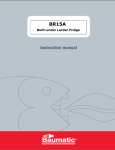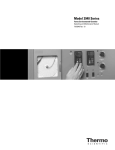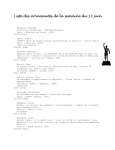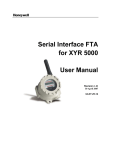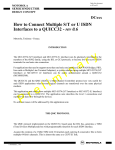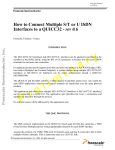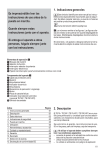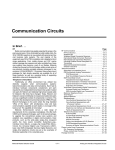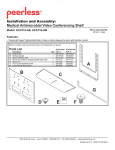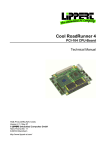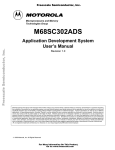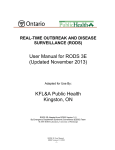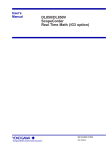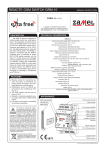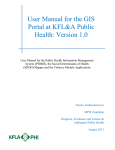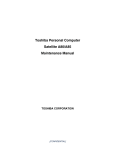Download MC145572EVK - NXP Semiconductors
Transcript
MOTOROLA Freescale Semiconductor, Inc. SEMICONDUCTOR TECHNICAL DATA Order this document by MC145572EVK/D Advance Information MC145572EVK Freescale Semiconductor, Inc... ISDN U-Interface Transceiver Evaluation Kit This document contains information on a new product. SpeciÞcations and information herein are subject to change without notice. REV 2 11/97 For More Information On This Product, Go to: www.freescale.com Freescale Semiconductor, Inc. CONTENTS Paragraph Number Page Number Title Freescale Semiconductor, Inc... SECTION 1 INTRODUCTION 5 1.1 ORGANIZATION OF DATA SHEET . . . . . . . . . . . . . . . . . . . . . . . . . . . . . . . . . . 5 1.2 INTRODUCTION . . . . . . . . . . . . . . . . . . . . . . . . . . . . . . . . . . . . . . . . . . . . . . . . . 5 1.3 FEATURES . . . . . . . . . . . . . . . . . . . . . . . . . . . . . . . . . . . . . . . . . . . . . . . . . . . . . 1.3.1 General. . . . . . . . . . . . . . . . . . . . . . . . . . . . . . . . . . . . . . . . . . . . . . . . . . . 1.3.2 Hardware . . . . . . . . . . . . . . . . . . . . . . . . . . . . . . . . . . . . . . . . . . . . . . . . . 1.3.3 Software . . . . . . . . . . . . . . . . . . . . . . . . . . . . . . . . . . . . . . . . . . . . . . . . . . 7 7 7 7 1.4 BLOCK DIAGRAM . . . . . . . . . . . . . . . . . . . . . . . . . . . . . . . . . . . . . . . . . . . . . . . . 8 1.5 GETTING STARTED . . . . . . . . . . . . . . . . . . . . . . . . . . . . . . . . . . . . . . . . . . . . . . 8 SECTION 2 HARDWARE REFERENCE 12 2.1 U-INTERFACE . . . . . . . . . . . . . . . . . . . . . . . . . . . . . . . . . . . . . . . . . . . . . . . . . . . 2.1.1 Line Interface Circuitry . . . . . . . . . . . . . . . . . . . . . . . . . . . . . . . . . . . . . . . 2.1.2 Crystal Oscillator (LT Mode). . . . . . . . . . . . . . . . . . . . . . . . . . . . . . . . . . . 2.1.3 Crystal Oscillator (NT Mode) . . . . . . . . . . . . . . . . . . . . . . . . . . . . . . . . . . 12 12 14 14 2.2 S/T-INTERFACE . . . . . . . . . . . . . . . . . . . . . . . . . . . . . . . . . . . . . . . . . . . . . . . . . 14 2.3 MICROCONTROLLERS . . . . . . . . . . . . . . . . . . . . . . . . . . . . . . . . . . . . . . . . . . . 2.3.1 Status LEDs . . . . . . . . . . . . . . . . . . . . . . . . . . . . . . . . . . . . . . . . . . . . . . . 15 15 2.4 EIA-232 INTERFACE. . . . . . . . . . . . . . . . . . . . . . . . . . . . . . . . . . . . . . . . . . . . . . 16 2.5 BIT ERROR ANALYZER INTERFACE . . . . . . . . . . . . . . . . . . . . . . . . . . . . . . . . 2.5.1 Setting Up a Bit Error Rate Test. . . . . . . . . . . . . . . . . . . . . . . . . . . . . . . . 17 19 2.6 MC145572EVK TEST HEADERS . . . . . . . . . . . . . . . . . . . . . . . . . . . . . . . . . . . . 2.6.1 NT Signal Header (JP7) Pin Descriptions . . . . . . . . . . . . . . . . . . . . . . . . 2.6.2 LT Signal Header (JP26) Pin Descriptions. . . . . . . . . . . . . . . . . . . . . . . . 22 24 27 2.7 DIP SWITCH FUNCTIONS . . . . . . . . . . . . . . . . . . . . . . . . . . . . . . . . . . . . . . . . . 2.7.1 NT Side GCI Parameters DIP Switch S1 . . . . . . . . . . . . . . . . . . . . . . . . . 2.7.2 NT Side Configuration DIP Switch S4 . . . . . . . . . . . . . . . . . . . . . . . . . . . 2.7.3 LT Side GCI Parameters DIP Switch S1 . . . . . . . . . . . . . . . . . . . . . . . . . 2.7.4 LT Side Configuration DIP Switch S7. . . . . . . . . . . . . . . . . . . . . . . . . . . . 30 30 31 31 32 2.8 POWER SUPPLY . . . . . . . . . . . . . . . . . . . . . . . . . . . . . . . . . . . . . . . . . . . . . . . . 32 SECTION 3 SOFTWARE DESIGN DESCRIPTION 3.1 33 OPERATING PROCEDURES . . . . . . . . . . . . . . . . . . . . . . . . . . . . . . . . . . . . . . . 3.1.1 Power On Reset and Terminal Prompt . . . . . . . . . . . . . . . . . . . . . . . . . . 3.1.2 Command Line Interface . . . . . . . . . . . . . . . . . . . . . . . . . . . . . . . . . . . . . 3.1.3 Push-Button Activation . . . . . . . . . . . . . . . . . . . . . . . . . . . . . . . . . . . . . . . 3.1.4 General Comments About Activation . . . . . . . . . . . . . . . . . . . . . . . . . . . . 3.1.5 Embedded Operations Channel, Register R6 . . . . . . . . . . . . . . . . . . . . . For More Information On This Product, Go to: www.freescale.com 33 33 33 34 34 34 MC145572EVK 3 Freescale Semiconductor, Inc. CONTENTS (Continued) Paragraph Number Freescale Semiconductor, Inc... 3.2 Title Page Number COMMAND SET . . . . . . . . . . . . . . . . . . . . . . . . . . . . . . . . . . . . . . . . . . . . . . . . . 3.2.1 ACT Ñ Activation/Deactivation Menu . . . . . . . . . . . . . . . . . . . . . . . . . . . 3.2.2 BRL Ñ Read/Write LT U-Interface Transceiver Byte Register . . . . . . . . 3.2.3 BRN Ñ Read/Write NT U-Interface Transceiver Byte Register . . . . . . . . 3.2.4 BRS Ñ Read/Write S/T-Interface Transceiver Register . . . . . . . . . . . . . 3.2.5 BRT Ñ Read/Write S/T-Interface Transceiver Byte Register . . . . . . . . . 3.2.6 CLR Ñ Clear febe/nebe Registers. . . . . . . . . . . . . . . . . . . . . . . . . . . . . . 3.2.7 DEA Ñ Activation/Deactivation Menu . . . . . . . . . . . . . . . . . . . . . . . . . . . 3.2.8 DIS Ñ Display Formatted Registers . . . . . . . . . . . . . . . . . . . . . . . . . . . . 3.2.9 eoc Ñ Embedded Operations Channel Menu . . . . . . . . . . . . . . . . . . . . . 3.2.10 HEL Ñ Help Menu . . . . . . . . . . . . . . . . . . . . . . . . . . . . . . . . . . . . . . . . . . 3.2.11 LOF Ñ Disable LT M4 Handler . . . . . . . . . . . . . . . . . . . . . . . . . . . . . . . . 3.2.12 LON Ñ Enable LT M4 Handler . . . . . . . . . . . . . . . . . . . . . . . . . . . . . . . . 3.2.13 LPU Ñ U-Interface Transceiver Analog Loop-Backs . . . . . . . . . . . . . . . . 3.2.14 MM Ñ Modify Memory . . . . . . . . . . . . . . . . . . . . . . . . . . . . . . . . . . . . . . . 3.2.15 NOF Ñ Disable NT1 Function . . . . . . . . . . . . . . . . . . . . . . . . . . . . . . . . . 3.2.16 NON Ñ Enable NT1 Function . . . . . . . . . . . . . . . . . . . . . . . . . . . . . . . . . 3.2.17 NRL Ñ Read/Write LT U-Interface Transceiver Nibble Register . . . . . . . 3.2.18 NRN Ñ Read/Write NT U-Interface Transceiver Nibble Register . . . . . . 3.2.19 NRS Ñ Read/Write S/T-Interface Transceiver Nibble Register . . . . . . . . 3.2.20 NRT Ñ Read/Write S/T-Interface Transceiver Nibble Register . . . . . . . . 3.2.21 ORL Ñ Read/Write LT U-Interface Transceiver Byte Register . . . . . . . . 3.2.22 ORN Ñ Read/Write NT U-Interface Transceiver Overlay Register . . . . . 3.2.23 RES Ñ Reset S/T-Interface Transceiver and/or U-Interface Transceivers 34 35 37 38 38 39 39 39 39 41 43 44 44 44 46 47 47 47 48 49 49 50 50 51 MC145572EVK 4 For More Information On This Product, Go to: www.freescale.com Freescale Semiconductor, Inc. LIST OF FIGURES Freescale Semiconductor, Inc... Paragraph Number Figure 1-1. Figure 1-2. Figure 1-3. Figure 1-4. Figure 2-1. Figure 2-2. Figure 2-3. Figure 2-4. Figure 2-5. Figure 2-6. Figure 2-7. Figure 2-8. Figure 2-9. Title Page Number Motorola Silicon Applications and the MC145572EVK . . . . . . . . . . . . . . . . . MC145572EVK Functional Block Diagram . . . . . . . . . . . . . . . . . . . . . . . . . . MC145572EVK DIP Switch Configuration . . . . . . . . . . . . . . . . . . . . . . . . . . . External Connections to the MC145572EVK . . . . . . . . . . . . . . . . . . . . . . . . . NT Line Interface Schematic and Component Values . . . . . . . . . . . . . . . . . . LT Line Interface Schematic and Component Values . . . . . . . . . . . . . . . . . . EIA-232 Interface Schematic . . . . . . . . . . . . . . . . . . . . . . . . . . . . . . . . . . . . . Access to Bit Error Analyzer Interface Through J22 and J9 Headers . . . . . . BERT Gated Clock Ñ 8-Bit Gated Clock . . . . . . . . . . . . . . . . . . . . . . . . . . . . BERT Gated Clock Ñ 10-Bit Gated Clock . . . . . . . . . . . . . . . . . . . . . . . . . . . Bit Error Rate Test Set-Up NT Side . . . . . . . . . . . . . . . . . . . . . . . . . . . . . . . . Loop-Back Modes for the MC145572EVK . . . . . . . . . . . . . . . . . . . . . . . . . . . Power Connector Pin Assignments . . . . . . . . . . . . . . . . . . . . . . . . . . . . . . . . 7 9 10 11 14 14 17 18 19 19 21 22 33 For More Information On This Product, Go to: www.freescale.com MC145572EVK 5 Freescale Semiconductor, Inc. 1 Freescale Semiconductor, Inc... INTRODUCTION 1.1 ORGANIZATION OF DATA SHEET This document is composed of three major sections. Section 1 introduces the MC145572EVK U-Interface Transceiver Evaluation Kit with a brief description of the evaluation board and a list of key features. Also included at the end of Section 1 is ÒGetting Started,Ó a short tutorial to help begin working with the MC145572EVK. Section 2 is a brief description of the hardware design. Section 3 contains the command set descriptions and examples. IMPORTANT NOTE This UserÕs Manual Ñ MC145572EVK U-Interface Transceiver Evaluation Kit Revision 2 Ñ corresponds with MC145572EVK Printed Circuit Board Revision F with Þrmware version 2.01. If a discrepancy exists between this document and the MC145572 data sheet, the MC145572 data sheet should take precedence. 1.2 INTRODUCTION The MC145572EVK U-Interface Transceiver Evaluation Kit provides Motorola ISDN customers a convenient and efÞcient vehicle for evaluation of the MC145572 ISDN U-Interface Transceiver. The approach taken to demonstrate the MC145572 U-Interface Transceiver is to provide the user with a fully functional NT1 (Network Termination Type 1) connected to an LT (Line Termination). An NT1 provides transparent 2B+D data transfer between the U- and S/T-Interfaces. In addition, it provides for network initiated maintenance procedures. The MC145572EVK does not terminate any ISDN call control messages. It also does not terminate any maintenance messages received over the S/T-Interface. The MC145572EVK U-Interface Transceiver Evaluation Kit can be used as an NT1 card or as an LT card. The left half of the card is the NT1, while the right half of the card is the LT. Alternatively, it can be thought of as having both ends of the two-wire U-Interface, extending from the customer premise (NT1) to the switch line card (LT) on a single, stand-alone evaluation board. Figure 1-1 shows a typical ISDN application using the MC145572 and the MC145574. The kit provides the ability to interactively manipulate status registers in the MC145572 U-Interface Transceiver as well as in the MC145574 S/T-Interface Transceiver with the aid of an external terminal. A unique combination of hardware and software features allows for stand-alone or terminal activation of the U-Interface and as such provide an excellent platform for NT1 and LT hardware/software development. The NT1 function can be disabled by putting DIP switch S4-10 in the NT1 DIS position. MC145572EVK 6 For More Information On This Product, Go to: www.freescale.com SCP For More Information On This Product, Go to: www.freescale.com MC145480 CODEC X-FRMRS AND LINE I/F IDL BUS TA MC145480 CODEC X-FRMRS AND LINE I/F IDL BUS HOST BUS MCMC68SC302 CLOCK SCP MC145574 S/T-INTERFACE MC145574 S/T-INTERFACE CLOCK MCMC68SC302 HOST BUS TA MC145480 CODEC IDL BUS HOST BUS MCMC68SC302 CLOCK SCP MC145572 U-INTERFACE X-FRMRS AND LINE I/F NT1/TE1 MC145574 S/T-INTERFACE X-FRMRS AND LINE I/F NT1 MCU SCP IDL Freescale Semiconductor, Inc... MC145572 U-INTERFACE MC145572 U-INTERFACE SWITCHING EQUIPMENT LT MC145572 U-INTERFACE LT Freescale Semiconductor, Inc. Figure 1-1. Motorola Silicon Applications and the MC145572EVK MC145572EVK 7 Freescale Semiconductor, Inc. 1.3 FEATURES 1.3.1 · · · · Provides Stand-Alone NT1 and LT on Single Board On-Board 68HC05 Microcontroller with Resident Monitor Software Convenient Access to Key Signals NT1 and LT Software Development Platform Freescale Semiconductor, Inc... 1.3.2 · · · · · · · Hardware + 5 V Only Power Supply ÒPush-ButtonÓ Activation of U-Interface from NT1 Stand-Alone Operation for Bit Error Rate Testing Gated Data Clocks Provided for Bit Error Rate Testing Can Be Used as a U- or S/T-Interface Terminal Development Tool On-Board 5 ppm LT Frequency Reference EIA-232 (V.28) Serial Port for Terminal Interface 1.3.3 · · · · · · · General Software Stand-Alone or Terminal Operation Resident Firmware Monitor for User Control of Board Activation and Deactivation Menus Embedded Operations Channel Microcontroller Controlled or Automatic Activation/Deactivation Access to All Maintenance Channels MC68HC05 Assembly Language Source Code Available MC145572EVK 8 For More Information On This Product, Go to: www.freescale.com Freescale Semiconductor, Inc. 1.4 BLOCK DIAGRAM Following is a basic functional block diagram for the MC145572EVK U-Interface Transceiver Evaluation Kit (Figure 1-2). While the board is capable of activating Òstand-alone,Ó the user may decide to use a single ASCII terminal to gain total control of the MC145572EVKÕs activities. NT U-INTERFACE LT U-INTERFACE NETWORK TERMINATION MC145572 ISDN U-INTERFACE TRANSCEIVER IDL Freescale Semiconductor, Inc... S/T MC145574 ISDN S/T-INTERFACE TRANSCEIVER MC145572 ISDN U-INTERFACE TRANSCEIVER LINE TERMINATION IDL REFERENCE CLOCK GENERATOR EXT CLK SCP BERTCLK GATED CLOCK GENERATOR MC68HC705 MICROCONTROLLER 5 ppm CLOCK SOURCE MC145407 GATED CLOCK GENERATOR BERTCLK RS-232 Figure 1-2. MC145572EVK Functional Block Diagram 1.5 GETTING STARTED This section is provided to facilitate the userÕs introduction to the MC145572EVK. To maximize efÞciency when working with the MC145572EVK, it is recommended that the user become familiar with the organization of this document as well as the MC145572 U-Interface Transceiver data sheet. To identify a starting point, power up the board and activate the U-Interface immediately. The only equipment needed is a 5 V, 250 mA power supply, a two-wire U-Interface cable, and the MC145572EVK. NOTE The board shipped from the factory was thoroughly tested and veriÞed to function properly prior to shipment. If you experience any problems or difÞculties with the operation of the MC145572EVK, do not hesitate to call the factory or your local Motorola representative for assistance. 1. Remove the board from its conductive environment at a static-controlled station. 2. Examine the board and its components to make certain nothing was damaged during shipment of the board. 3. Verify that the ICs are seated properly in the socket. For More Information On This Product, Go to: www.freescale.com MC145572EVK 9 Freescale Semiconductor, Inc. 4. Become familiar with the layout and the various connectors. Locate the power connector J19. Locate the U-Interface connectors, J2 (LT U-Interface side) and J12 (NT U-Interface side). The DIP switches arrive preset from the factory (see Figure 1-3). Refer also to DIP Switch Functions in Section 2.8, for an explanation of the function of each switch. Do not change the position of any DIP switch until you are completely familiar with its function. NT U CONFIG Freescale Semiconductor, Inc... OPEN LT U CONFIG S4 S2 CLOSED CLOSED OPEN FRON 1 RFOFF MAS 1 SLV FSR 2 FSX=FSR MAS 2 SLV 8 3 10 FSR 3 FSX=FSR IDL2 4 GCI 8 4 10 PAR 5 SER IDL2 5 GCI T_MAS 6 T_SLV PAR 6 SER 7 RESMCU 7 RF=FSR FIX 8 ADP 8 TE 9 NT NT1EN 10 NT1DIS NT GCI CONFIG OPEN S3 LT GCI CONFIG CLOSED OPEN CLOSED S1 S0HI 1 S0LOW SOHI 1 S0LOW S1HI 2 S1LOW S1HI 2 S1LOW S2HI 3 S2LOW S2HI 3 S2LOW GCI2048 4 GCI512 GCI2048 4 GCI512 IN1HI 5 IN1LOW IN1HI 5 IN1LOW IN2HI 6 IN2LOW IN2HI 6 IN2LOW Figure 1-3. MC145572EVK DIP Switch Configuration MC145572EVK 10 For More Information On This Product, Go to: www.freescale.com Freescale Semiconductor, Inc. ISDN LOOP SIMULATOR 5 V/250 mA +5 GND EIA-232C Freescale Semiconductor, Inc... J12 J2 PB1 J19 J16 TERMINAL LT NT PB2 Figure 1-4. External Connections to the MC145572EVK The board is now ready for power. 5. Connect + 5 V and ground leads to the proper pins on J19. Make certain the integrity of the power supply being used has been veriÞed to prevent any damage to the MC145572EVK. 6. Turn the power supply on. If everything is okay, the red LED ÒD27Ó near the power connector will be illuminated. 7. Connect a twisted pair between the two RJ-45 connectors, J12 and J2, at the top of the board. This is the ÒU-loop.Ó 8. Depress the RESET push-button (PB1). This push-button is located adjacent to the power connector. 9. Now depress the push-button marked ACT/DEA (PB2) located near the status LEDs. The yellow TP/AIP status LEDs on both the NT1 and LT sides should illuminate, followed by both green LEDs, SFS and LINKUP. This activation process should occur within 15 seconds. The NT side default activation mode is an NT1 so the S/T-Interface is also trying to activate by continually transmitting the INFO1 state on the S/T-Interface. If the red LED EI comes on, indicating an activation error has occurred, re-check the integrity of the connections (i.e., does the ÒU-loopÓ twisted pair show continuity?). Retry if necessary. For More Information On This Product, Go to: www.freescale.com MC145572EVK 11 Freescale Semiconductor, Inc. 10. If available, connect an ASCII terminal to J16 (the DB-25 connector on the NT1 side of the board). Make certain the terminal is set for 9600 baud, 1 stop bit, and no parity. If there is no response, reverse the EIA-232 Tx and Rx signals by changing the jumpers on JP13. 11. Depress the RESET push-buttons and verify that the ÒNTLT>Ó prompt has appeared on the terminal screen. Freescale Semiconductor, Inc... Continue reading this document to learn more about the operation of the MC145572EVK U-Interface Transceiver Evaluation Kit. As always, please phone the factory for assistance with any problems encountered while ÒGetting Started.Ó MC145572EVK 12 For More Information On This Product, Go to: www.freescale.com Freescale Semiconductor, Inc. 2 Freescale Semiconductor, Inc... HARDWARE REFERENCE NOTE Refer to the MC145572EVK Printed Circuit Board and to the MC145572 U-Interface Transceiver data sheet to supplement this section. Please contact the factory before committing design to PCB to be guaranteed notiÞcation of any improvements to the following circuitry. The schematic of the MC145572EVK is in Appendix A of this manual. 2.1 U-INTERFACE The U-Interface is implemented with MotorolaÕs single chip MC145572 U-Interface Transceiver (U10 on the NT1 and U1 on the LT side), providing ISDN Basic Rate Access capability for twisted-pair loops with conformance to ANSI T1.601-1992. For additional speciÞcations on designing with and the operation of the MC145572, refer to the MC145572 U-Interface Transceiver data sheet in addition to this document. 2.1.1 Line Interface Circuitry While the published speciÞcations for the U-Interface Transformer are intended as such, it is realized that application speciÞc parameters (i.e., primary protection) may cause some variation in transformer speciÞcations or published line interface values. Figure 2-1 (representing the NT) and Figure 2-2 (representing the LT) show the suggested architecture of the line interface. The schematic gives the corresponding values used to interface the MC145572 to the line using Pulse Engineering PE68628 transformer. Currently all resistor values are accurate to 1%. Secondary protection on the MC145572EVK for the NT1 side and the LT side are implemented using a simple diode bridge consisting of four MMBD7000LT1s (D5, D6 on LT side and D18, D19 on NT1 side) to clamp voltage surges to the power supply rail and to ground. Two populated two surge suppressors (D14, D15, D22 on the NT1 side and D1, D2, D7 on the LT side) are on the line side of the transformer. The circuit board has been laid out to allow resistors to be included in the line side circuitry to provide voltage spike and power cross protection. These resistors, R17, R21 on the NT side and R1, R6 on the LT side, are populated and jumpers are installed at JP8, JP11 on the NT1 side and JP3, JP20 on the LT side. The jumpers can be inserted if it is desired to bypass the line side protection circuitry. The MC145572EVK does not directly address the issue of primary protection. For More Information On This Product, Go to: www.freescale.com MC145572EVK 13 Freescale Semiconductor, Inc. JP8 +5 V J14 1 R17 2 D18 R19 JP7 TxP D15 R18 1 RxP 2 C33 C37 MC145572 3 2 D14 1 4 RJ45 5 R20 JP9 RxN 6 Freescale Semiconductor, Inc... D19 7 D22 8 R22 J12 TxN +5V R21 1 : 1.25 R23 1 JP11 2 T2 J13 JP12 Figure 2-1. NT Line Interface Schematic and Component Values JP3 +5V JP4 1 R1 2 D5 R3 JP2 TxP D2 1 R2 RxP 2 C37 C8 MC145572 3 2 D1 1 4 RJ45 5 R5 JP4 RxN 6 D6 7 D7 8 R7 TxN J12 +5V R6 1 : 1.25 R8 1 JP5 2 T1 J3 Figure 2-2. LT Line Interface Schematic and Component Values MC145572EVK 14 For More Information On This Product, Go to: www.freescale.com JP6 Freescale Semiconductor, Inc. 2.1.2 Crystal Oscillator (LT Mode) In the LT mode, the internal phase locked loop (PLL) of the MC145572 generates a 20.48 MHz clock which is phase locked to an 8 kHz reference clock applied at the FREQREF pin. This assures that the transmitted 2B1Q signal is synchronized to the 8 kHz frequency reference. A single pullable crystal, Y1, is all that is required for the MC145572 oscillator. All other frequency pulling circuitry is internal to the MC145572. It is also possible to provide an external 8 kHz frequency reference rather than using the 8 kHz frequency reference generated on-board from the 5 ppm oscillator, Y5. This is accomplished using the RFoff-RFon switch of S2-1 and connecting the external reference to EXTREF of J9. RFoff selects the off-board 8 kHz frequency reference and RFon selects the on-board 8 kHz frequency reference. See also the explanation for S2-1 and S2-7 in Section 2.7.2. Freescale Semiconductor, Inc... 2.1.3 Crystal Oscillator (NT Mode) The NT-conÞgured MC145572 U10, requires only a single pullable crystal, Y2, for its oscillator. All other frequency pulling circuitry is internal to the MC145572. 2.2 S/T-INTERFACE The S/T-Interface resides on the NT1 portion of the MC145572EVK and is implemented using the MC145574 S/T-Interface Transceiver (U17). The 600 mil 28-pin Plastic SOIC MC145574 conforms to both CCITT I.430 and ANSI T1.605 speciÞcations. External line interface circuitry for switching between NT and TE operating modes is incorporated. Two 8-pin RJ-45 telephone jacks are used at the S/T-Interface, one conÞgured for the NT mode (J24) of operation and one conÞgured for the TE mode (J23) of operation. The Tx pair, pins 4 and 5 on the NT jack and pins 3 and 6 on the TE jack, are driven by the TxP and TxN pins which act as a current limited differential voltage source. The drive resistance (R40, R42) is necessary to conform to the ANSI T1.605 pulse mask speciÞcation. A dual 2.5:1 turns ratio transformer (T4A:B) is used to couple the Tx and Rx pairs to the 4-wire interface. A high frequency 4-wire common mode choke transformer (T3 for TE and T5 for NT) provides an effective means of compliance with EMI suppression. The protection diodes (D29A:G, D30A:G MMAD1108) provide secondary protection to the MC145574, even when it is powered down, without loading the S/T-Interface bus. CCITT I.430, ETSI ETS 300012, and ANSI T1.605 specify that the S/T-interface voltage cannot exceed 1.6 times the nominal voltage of 750 mV (= 1.2 V). Since the MC145574 is designed to operate with 2.5:1 turns ratio transformers, the diode structure is required to provide protection, while not adversely affecting the S/T-interface when power is removed from the device. This diode structure also protects the circuit against electrostatic discharges (ESD) and latch-up. The S/T-Interface Transceiver implementation on this board can be used in either NT or TE mode. Pin 4, TE/NT(L), of the MC145574 determines whether the chip is in NT or TE mode of operation. When conÞgured as a TE, pins 9 and 8 are used as DREQUEST and DGRANT, respectively. The DREQUEST pin is used by an external controller such as the MC145488 DDLC or the MC68302 IMP to request access to the D-Channel. When the S/T-Interface Transceiver gains access to the D-Channel time slot on the S/T-Interface bus, it asserts DGRANT high, informing the external controller that it can transmit its D-Channel data in the next IDL D time slot. In the NT mode, pin 6 performs the FIX and TFSC functions. FIX tells the S/T-Interface Transceiver to use Fixed or Adaptive timing recovery. TFSC is asserted when frame synchronization has been achieved at the S/T-Interface bus. For a more complete discussion on D-Channel operation, please refer to Section 11 of the MC145574/75 S/T-Interface Transceiver data manual. With the left side of the board operating as an NT1, the MC145574 S/T-Interface Transceiver is in the NT mode, operating as an IDL Slave, and is receiving its Clock and Sync signals from the MC145572 For More Information On This Product, Go to: www.freescale.com MC145572EVK 15 Freescale Semiconductor, Inc. U-Interface Transceiver. Access to the control registers within the S/T-Interface Transceiver is gained through the SCP Interface. The registers are displayed and changed via resident software on the MC145572EVK. A complete description of the S/T-Interface Transceiver registers can be found in Sections 8, 9, and 10 of the MC145574 S/T-Interface Transceiver data sheet. 2.3 MICROCONTROLLERS Freescale Semiconductor, Inc... The MC145572EVK is an MC68HC705C8 microcontroller-based system. One microcontroller resides on the board; U15 on the NT1 side which controls both the NT1 and the LT sides. The hardware RESET push-button is located next to the power supply connection for the microcontroller. U5 must be populated for the display LEDs to operate properly. The U-Interface may be activated using an ASCII terminal connected to the EIA-232 (V.28) port marked J16 on the NT1 side. The board may be activated as it Òstands aloneÓ with the push of a button. The default activation mode for the Activate/Deactivate push-button, PB2 (located near the front of the board), is as an NT1, with INFO1 continually transmitted on the S/T-Interface until it receives INFO2. When DIP switch S4-10 is in the NT1DIS position, the NT1 functionality is disabled. The LT side initiates activation on the U-Interface. Eight status LEDs (D10, D11, D12, and D13 on LT side and D23, D24, D25, and D26 on the NT1 side) are continuously updated by the MC68HC705C8s to provide the user with a visual update of the U-Interface activation status. When the MC145572EVK is reset, it defaults to NT1 function enabled and automatic handling of M4 maintenance channel on the LT side U-transceiver. The NT1 function can also be disabled by entering the ÒNOFÓ command. The LT maintenance can be disabled by entering the ÒLOFÓ command. See Section 3.2 for more information on LOF, LON, NOF, and NON commands. 2.3.1 Status LEDs Ten status LEDs are provided on the MC145572EVK to offer the user a quick visual update to critical status parameters. One red LED, D27 on the LT, is located near the power connector and is illuminated when + 5 V is applied to the board. One green LED (D31) marked S/T ACT located near the PB2 (ACT/DEA) push button, illuminates to indicate that the MC145574 when conÞgured as an NT has achieved frame synchronization. Located on both sides of the board are four LEDs representing Nibble Register 1 (NR1) of each U-Interface Transceiver. The LEDs in each bank are each marked with LINKUP, EI, SFS, and TP/AIP. They map directly to the register contents as shown below. b3 b2 b1 b0 NR1 Linkup Error Indication Superframe Sync Transparent/ Activation in Progress NT (LED Silkscreen) NT LINKUP NT EI NT SFS NT TP/AIP LT (LED Silkscreen) LT LINKUP LT EI LT SFS LT TP/AIP NOTE The received data is not transmitted on the IDL2 Interface until Linkup is a 1, SFS is a 1, TP/AIP is a 1, and either CustEn (see NR2 in MC145572 U-Interface Transceiver data sheet) or VerifAct is a 1 (see BR9 in MC145572 U-Interface Transceiver data sheet). MC145572EVK 16 For More Information On This Product, Go to: www.freescale.com Freescale Semiconductor, Inc. 2.4 EIA-232 INTERFACE The MC145572EVK provides one connector for communication between a remote ASCII terminal and the on-board microcontroller Serial Communications Interface (SCI). J16 resides on the NT1 side. The connector is an industry standard DB-25 type and bring, transmit, and receive data on- or off-board via MotorolaÕs MC145407 + 5 V EIA-232D Driver/Receiver. J16 24 23 22 21 20 GROUND 19 18 17 DATA TO/FROMASCII TERMINAL 16 15 14 13 1* 12 2** 11 10 9 8 7 6 5 Tx3Rx2 25 Rx3Tx2 Freescale Semiconductor, Inc... The option is also provided to swap the Transmit and Receive pins with respect to the ASCII terminal data connector. This appears in the form of a set of jumpers located near J16. With the jumpers populated as in case 1 in Figure 2-3, the receive signal is present on pin 2 and the transmit signal on pin 3 (Rx2 Ð Rx2 and Tx3 Ð Tx3). Conversely in case 2, Rx2 Ð Rx2 and Tx3 Ð Tx3, the transmit signal is present on pin 2 and the receive on pin 3. This option is useful when the user must use a cable in which the Tx/Rx polarity at pins 2 and 3 is not known. Pin 7 of both J16 is circuit board ground Ñ all other pins (1, 4 Ð 6, 8 Ð 25) are no connects. MC145407 Rx INPUT 4 Rx2 3 DO3Tx3 2 Tx OUTPUT DI3 1 TO MCU RECEIVE DATA IN FROM MCU TRANSMIT DATA OUT * Rx3Tx2, with jumpers populated on this vertical column. ** Tx3Rx2, with jumpers populated on this vertical column. Figure 2-3. EIA-232 Interface Schematic For More Information On This Product, Go to: www.freescale.com MC145572EVK 17 Freescale Semiconductor, Inc. 2.5 BIT ERROR ANALYZER INTERFACE The MC145572EVK ISDN U-Interface Evaluation Kit provides TTL-compatible gated clocks for the B1, B2, and D time slots to allow easy connection to a bit error rate tester. This is accomplished with the use of glue logic. Access to these gated clock signals is through the 2 x 20 headers (J9 on the LT side and J22 on the NT1 side). Figure 2-4 details the connections on both of these headers. The clocks are output in either an 8- or 10-bit boundary mode at the IDL clock speed. The MC145572EVK is shipped from the factory conÞgured so its gated clock outputs are derived from the TSEN output, pin 25, gated with the DCL signal from the IDL2 interface. The 2B+D format is the IDL 10-bit frame. It can be changed to IDL 8-bit frame format by setting BR7(b0) to a 1 in the appropriate U Transceiver. Freescale Semiconductor, Inc... 1 2 1 2 DREQ GND LTFREF GND DGRANT GND EXTREF GND NTSCPENL GND GND STSCPENL GND GND LTSCPENL GND LTSCPENL GND SCPCLK GND SCPCLK GND SCPTX GND SCPTX GND SCPRX GND SCPRX GND NTIRQL GND LTIRQL GND NTIDLCLK GND LTIDLCLK GND NTIDLRX GND LTIDLRX GND NTIDLTX GND LTIDLTX GND NTFSR GND LTFSR GND NTFSX GND LTFSX GND IRQLT GND 8 kHz GND NTSFAR GND LTSFAR GND NTSFAX GND LTSFAX GND NTFREF GND NTFREFO GND LTFREFO GND NTGTCLK GND LTGTCLK GND 39 GND 40 J22 (NT) 39 40 J9 (LT) Figure 2-4. Access to Bit Error Analyzer Interface Through J22 and J9 Headers MC145572EVK 18 For More Information On This Product, Go to: www.freescale.com Freescale Semiconductor, Inc. The timing diagrams for each of these modes are shown in Figure 2-5 and Figure 2-6. One example of a bit error rate test set-up is explained in the following section. DCL FSR B1 B1 B1 B1 B1 B1 B1 B1 B2 B2 B2 B2 B2 B2 B2 B2 D D B1 B1 B1 B1 B1 B1 B1 B1 B2 B2 B2 B2 B2 B2 B2 B2 D D DOUT Freescale Semiconductor, Inc... DIN (TSEN) " LTSFAR NTSFAR LTGTCLK NTGTCLK NOTE: These clocks are available only when either OR7(b5) or OR8(b3) is set to 1. The example shown is for when the MC145572 is conÞgured as follows: BR7(b0)=1, OR7(b5)=1, OR8(b3)=1. Figure 2-5. BERT Gated Clock Ñ 8-Bit Gated Clock DCL FSR B1 B1 B1 B1 B1 B1 B1 B1 D B2 B2 B2 B2 B2 B2 B2 B2 D B1 B1 B1 B1 B1 B1 B1 B1 D B2 B2 B2 B2 B2 B2 B2 B2 D DOUT DIN (TSEN) " LTSFAR NTSFAR LTGTCLK NTGTCLK NOTE: These clocks are available only when either OR7(b5) or OR8(b3) is set to 1. The example shown is for when the MC145572 is conÞgured as follows: BR7(b0)=0, OR7(b5)=1, OR8(b3)=1. Figure 2-6. BERT Gated Clock Ñ 10-Bit Gated Clock For More Information On This Product, Go to: www.freescale.com MC145572EVK 19 Freescale Semiconductor, Inc. 2.5.1 Setting Up a Bit Error Rate Test Bit error rate testing with two different testers has been performed. The Hewlett Packard 1645A Data Error Analyzer and The Telecommunications Techniques Corporation FIREBERD 6000 with Lab Interface Adapter have successfully been connected to the MC145572EVK. Any bit error test that accepts TTL level signals and external data clocks up to 2.56 MHz at TTL levels may be used. The clock interface supports synchronous clocked data through the use of gated clocks running at IDL rates of 512 kHz, 2.048 MHz, or 2.56 MHz, as determined by register BR7(b2) and OR7(b4) of the U-Interface Transceiver. CAUTION The MC145572EVK does not support EIA-232, RS-422, 50W, or RS-485 interfaces to bit error rate testers. Freescale Semiconductor, Inc... To demonstrate the connection of the MC145572EVK U-Interface Transceiver Evaluation Kit to a bit error rate tester, detailed instructions for one test set-up follows. EXAMPLE: Executing a 2B+D Loop-Back to the U-Interface at the LT End. This example shows how to connect a bit error rate tester to the MC145572EVK. Refer to Figure 2-7 for connection details. The data ßow for this example occurs as follows: data is input to the board by the BERT box on NTRXDATA at the NT1. This data is then input to the MC145572 where it is framed, coded, and transmitted over the U-Interface to the LT MC145572, and looped-back internal to the LT MC145572. The data is then transmitted back to the NT MC145572 over the U-Interface, decoded, deframed, and output from the NT MC145572 on NTTXDATA to the BERT box where it is compared to the data originally transmitted. 1. Make the following connections to the Bit Error Rate Tester as shown in Figure 2-7. a. Connect NTTXDATA (BNC J20, Dout pin of the NT U-Interface Transceiver) to the Receive Data Input of the BERT box. b. Connect NTRXDATA (BNC JP18, Din pin of the NT U-Interface Transceiver) to the Transmit Data Output of the BERT box. c. Connect NTCLK (BNC J21, gated clock output for the B1+B2+D time slot) to the External Transmit and External Receive Clock inputs of the BERT box. 2. Verify that the DIP switches are set as in Figure 1-3 (valid for above-mentioned BERT boxes). 3. ConÞgure the bit error rate tester to transmit data on the rising edge of the data clock and receive data on the falling edge of the data clock. 4. Using an ASCII terminal connected to J16, activate the MC145572EVK using the activation menu item J. Activate both U chips, 2B+D loop back to U-Interface at LT end, disable S/T chip. 5. Begin bit error rate testing when status LEDs indicate loop is successfully activated. MC145572EVK 20 For More Information On This Product, Go to: www.freescale.com Freescale Semiconductor, Inc. BIT ERROR RATE TESTER EXTERNAL RxCLOCK EXTERNAL TxCLOCK Freescale Semiconductor, Inc... J18 NT RxDATA RECEIVE DATA IN J20 NT TxDATA TRANSMIT DATA OUT 30 W* J21 NT CLK GND *On some cases, this resistor may be needed to dampen ringing on clock transitions. Figure 2-7. Bit Error Rate Test Set-Up NT Side 2.5.1.1 OTHER LOOP-BACK TESTS. A variety of other loop-back modes may be implemented. Some modes are accessible through the activation menu while others require a working knowledge of the SCP registers and are accessed through the command line interface of the monitor program. Refer to Figure 2-8 and the text that follows for a description of some of these loop-backs. Refer also to the MC145572 data book loop-back section. The menu items referred to are for the combined NT/LT mode. For More Information On This Product, Go to: www.freescale.com MC145572EVK 21 Freescale Semiconductor, Inc. U-LOOP B E G A I IDL D Freescale Semiconductor, Inc... S/T MC145574 ISDN S/T-INTERFACE TRANSCEIVER MC145572 ISDN U-INTERFACE TRANSCEIVER F MC145572 ISDN U-INTERFACE TRANSCEIVER IDL H REFERENCE CLOCK GENERATOR EXT CLK SCP C BERTCLK GATED CLOCK GENERATOR MC68HC705 MICROCONTROLLER 5 ppm CLOCK SOURCE MC145407 GATED CLOCK GENERATOR BERTCLK RS-232 Figure 2-8. Loop-Back Modes for the MC145572EVK A: External Hardware IDL Loop-Back on NT1 Side. Place a jumper between BNC J18 NTRXDATA and BNC J20. Then, from the NT/LT activation menu, select option I or C. Or, from the command line interface, disable the S/T-Interface Transceiver by setting NR0(b3) of the MC145574 to a 1. The MC145574 can also be removed from the board. B: IDL Loop-Back Internal to S/T-Interface Transceiver. This loop-back may be implemented either from the NT/LT activation menu or directly from the command line interface. From the NT/LT activation menu, select option B or H. From the command line interface, enable a 2B+D IDL loop-back in the S/T-Interface Transceiver by setting NR6(b3) of the MC145574 to a 1. MC145572EVK 22 For More Information On This Product, Go to: www.freescale.com Freescale Semiconductor, Inc. C: Other S/T-Interface Transceiver Loop-Backs. A variety of S/T-Interface and IDL loop-backs may be initiated from the command line interface by setting BR6(b7 Ð b0) in the S/T-Interface Transceiver. Refer to the MC145574/75 S/T-Interface data sheet for more information. D: IDL Loop-Back Internal to NT U-Interface Transceiver Towards NT1 Side. This loop-back is also implemented via the command line interface by setting BR6(b3) and/or BR6(b2) and/or BR6(b1) in the NT U-Interface Transceiver to 1. Refer to the MC145572 U-Interface Transceiver data sheet for more information. E: NT U-Interface Transceiver Analog Loop-Backs Toward NT1 Side. Freescale Semiconductor, Inc... From command line interface, invoke ÒLPU N D.Ó See also the Loop-Back Modes section in the MC145572 U-Interface Transceiver data sheet. F: IDL Loop-Back Internal to U-Interface Transceiver Towards U-Interface. From LT activation menu, select option B. From the command line interface for either the LT or NT1 side, this loop-back is implemented by setting BR6(b7) and/or BR6(b6) and/or BR6(b5) to 1. G: LT U-Interface Transceiver Analog Loop-Backs Toward LT Side. From command line interface, invoke ÒLPU L D.Ó See also the Loop-Back Modes section in the MC145572 U-Interface Transceiver data sheet. H: IDL Loop-Back Internal to LT U-Interface Transceiver Towards Connector JP9. This loop-back is implemented from the command line interface by setting BR6(b3) and/or BR6(b2) and/or BR6(b1) in the LT side U-Interface Transceiver to 1. I: External Hardware IDL Loop-Back on LT Side. Place a jumper between BNC J7 LTRXDATA and BNC J8 LTXDATA. Then from the LT/NT activation menu, select option E or I. 2.6 MC145572EVK TEST HEADERS There are four headers on the MC145572EVK with signals of signiÞcant interest to the user. J22 Ñ Makes available key signals on the NT side such as the IDL, SCP, and bit error rate test interfaces. J11 and J17 Ñ Makes available key test signals from the NT side U-Interface Transceiver. J1 and J6 Ñ Makes available key test signals from the LT side U-Interface Transceiver. J9 Ñ Makes available key signals on the LT side such as the IDL, SCP, and bit error rate test interface. J1 and J11, 2 x 8 headers, make important MC145572 U-Interface Transceiver test signals easily accessible. Pins 2, 4, 6, and 10 can be decoded to generate an eye pattern. Also, an external cable can be connected to these headers if it is desired to operate the corresponding U-Interface Transceiver from a parallel data port. Refer to the MC145572 data sheet for the eye data application circuit and timing diagram. For More Information On This Product, Go to: www.freescale.com MC145572EVK 23 Freescale Semiconductor, Inc. Table 2-1. MC145572 Test Header (J11) Quick Reference, NT Side Freescale Semiconductor, Inc... Pin No. Silkscreen SCP Mode Parallel Port Mode GCI Mode 1 IRQNT_U IRQ IRQ N/C 2 20.48 MHz BUFXTAL D4 BUFXTAL 3 15.36 MHz 15.36 CLKOUT D3 15.36 CLKOUT 4 TxBCLK TxBCLK/FREFout/DCHin D6 FREFout 5 NTSCPCLK SCPCLK R/W IN2 8 SFSYNC/SFAX TxSFS/SFAX TxSFS/SFAX S0 9 NTSCPRx SCPRx D0 OUT1 10 4096 MHz 4.096 CLKOUT D3 4.096 CLKOUT 11 NTSCPEN SCPEN CS IN1 13 NTSCPTx SCPTx D1 OUT2 14 EYEDATA EYEDATA/DCHCLK D5 S2 15 +5V +5V +5V +5V 16 SYSCLK/ SFAR SYSCLK/SFAR/TSEN/20.48 MHz SYSCLK/SFAR/TSEN/ 20.48 MHz S1 6 RxBCLK RxBCLK/DCKOUT D7 CLKSEL 7,12 GND GND GND GND Pin No. Silkscreen SCP Mode Parallel Port Mode 1 IRQLT_U IRQ IRQ N/C 2 20.48 MHz BUFXTAL D4 BUFXTAL 3 15.36 MHz 15.36 CLKOUT D3 15.36 CLKOUT FREFout Table 2-2. MC145572 Test Header (J1) Quick Reference, LT Side GCI Mode 4 TxBCLK TxBCLK/FREFout/DCHin D6 5 LTSCPCLK SCPCLK R/W IN2 6 RxBCLK RxBCLK/DCKOUT D7 CLKSEL 8 SFSYN/SFAX TxSFS/SFAX TxSFS/SFAX S0 9 LTSCPRx SCPRx D0 OUT1 10 4096 MHz 4.096 CLKOUT D3 4.096 CLKOUT 11 LTSCPEN SCPEN CS IN1 13 SCPTx SCPTx D1 OUT2 14 EYEDATA EYEDATA/DCHCLK D5 S2 15 +5V +5V +5V +5V 16 SYSCLK/SFAR SYSCLK/SFAR/TSEN/20.48 MHz SYSCLK/SFAR/TSEN/ 20.48 MHz S1 7,12 GND GND GND GND MC145572EVK 24 For More Information On This Product, Go to: www.freescale.com Freescale Semiconductor, Inc. Freescale Semiconductor, Inc... Table 2-3. NT1 DATA Signal Header (J22) Quick Reference Pin No. Silkscreen 2 Ð 20 EVEN GND 1 DREQ Functional Description Ground S/T-Interface Transceiver DREQUEST 3 DGRANT S/T-Interface Transceiver DGRANT 5 NTSCPEN SCP Enable (NT U-Interface Transceiver) 7 STSCPEN SCP Enable ST (ST-Interface Transceiver) 9 LTSCPEN SCP Enable (LT U-Interface Transceiver) 11 NTSCPCLK 13 NTSCPTx 15 SCPRx SCP Receive Input to MC145572s 17 NTIRQL Interrupt Request (NT U-Interface Transceiver) 19 NTIDLCLK 21 NTIDLRx IDL Receive Input (NT U-Interface Transceiver) 23 NTIDLTx IDL Transmit Output (NT U-Interface Transceiver) 25 NTFSR FSR Frame Sync (NT U-Interface Transceiver) 27 NTFSX FSX Frame Sync (NT U-Interface Transceiver) 29 STIRQ Interrupt Request ST (S/T-Interface Transceiver) 31 NTSFAR Receive Superframe Alignment (NT U-Interface Transceiver) 33 NTSFAX Transmit Superframe Alignment (NT U-Interface Transceiver) 35 NTFREF Synchronized Recovered Clock Output When in MCU Mode of Operation (NT U-Interface Transceiver) 37 NTFREFO Synchronized Recovered Clock Output When in GCI Mode of Operation (NT U-Interface Transceiver) 39 NTGTCLK Demultiplexed Time Slot Clock Out (NT U-Interface Transceiver) SCP Clock SCP Transmit Output from MC145572s IDL Clock (NT U-Interface Transceiver) NOTE 1 NTIDLRx is connected to IDLTx pin of the MC145574 S/T-Transceiver. If it is desired for an external device to receive IDL data from the MC145574, the signal ÒNTIDLRxÓ must be connected to the IDL receive input of the external device. NOTE 2 NTIDLTx is connected to IDLRx pin of the MC145574 S/T-Transceiver. If it is desired for an external device to receive IDL data from the MC145574, the signal ÒNTIDLTxÓ must be connected to the IDL receive input of the external device. 2.6.1 NT Signal Header (JP7) Pin Descriptions DREQ: S/T-Interface Transceiver DREQUEST. In the TE mode, this signal is used to indicate to the MC145574 that an external device wishes to transmit a layer 2 frame to the NT on the D-channel. Refer to the MC145574 ISDN S/T-Interface Transceiver data sheet. DGRANT: S/T-Interface Transceiver DGRANT. In the TE mode, DGRANT operates as a D-channel grant or clear indication. Refer to the MC145574 ISDN S/T-Interface Transceiver data sheet. NTSCPEN: SCP Enable (NT U-Interface Transceiver SCP EN). This signal, when held low, selects the Serial Control Port (SCP) for the transfer of control, status, and data information into and out of the MC145572 U-Interface Transceiver on the NT1 side (U17). For More Information On This Product, Go to: www.freescale.com MC145572EVK 25 Freescale Semiconductor, Inc. STSCPEN: SCP Enable ST (S/T-Interface Transceiver SCP EN). This signal, when held low, selects the Serial Control Port (SCP) for the transfer of control, status, and data information into and out of the MC145574 S/T-Interface Transceiver (U17). LTSCPEN: SCP Enable (LT U-Interface Transceiver SCP EN). This signal, when held low, selects the Serial Control Port (SCP) for the transfer of control, status, and data information into and out of the MC145572 U-Interface Transceiver on the LT side (U1). NOTE: There is no corresponding interrupt line from U1 to the microcontroller on the NT side of the board. SCPCLK: SCP Clock (SCP CLK). Freescale Semiconductor, Inc... SCPCLK is used for controlling the transfer of data into and out of the SCP registers of the U17 S/T chip. Data is shifted into the devices from SCPRx on rising edges of SCPCLK. Data is shifted out of the devices on SCPTx on falling edges of SCPCLK. SCPCLK can be any frequency up to 4.096 MHz. SCPTx: SCP Transmit Output (SCP Tx). SCPTx is used to output control, status, and data information from the two MC145572 U-Interface Transceivers and the MC145574 S/T-Interface Transceiver. SCPRx: SCP Receive Input (SCP Rx). SCPRx is used to input control, status, and data information to the two MC145572 U-Interface Transceivers and the MC145574 S/T-Interface Transceiver. NTIRQ: Interrupt Request 1 (NT U-Interface Transceiver IRQ). The IRQL1 pin is an active low open drain output used to signal the MCU devices that an interrupt condition exists in the NT1 MC145572 U-Interface Transceiver (U10). On clearing the interrupt condition, the NTIRQ pin is returned to the high state. NTIDLCLK: (NT U-Interface Transceiver Pin DCL). This pin is an input when the MC145572 is in slave mode and an output when the MC145572 is in master mode, as established by switch S4-1, MAS/SLV. As a timing master in NT mode, this pin provides a 512 kHz, 2.048 MHz, or a 2.56 MHz clock frequency. In GCI mode the 2.56 MHz clock is not available. In GCI mode S1-4, GCI2048/GCI512 selects the clock rate on this pin. In slave mode this pin accepts any clock frequency from 512 kHz to 8.192 MHz, inclusive. NTIDLRx: (NT U-Interface Transceiver Pin Din). This pin is the input for the 2B+D data to be transmitted onto the NT1 U-Interface. Data bits are input on sequential falling edges of the NTIDLCLK signal beginning immediately after the FSX pulse occurs. The NTIDLRx pin is a donÕt care except during valid B- and D-channel data positions. Note that the M and the A bits used in the IDL Interface of the MC145574 S/T-Interface Transceiver are not used by the MC145572, and, therefore, are not received by the MC145572. NTIDLTx: (NT U-Interface Transceiver Pin Dout). This pin is the output for the 2B+D data received at the NT1 U-Interface. Data bits are output on rising edges of the IDL CLK signal beginning immediately after the FSR pulse occurs. The NTIDLTx signal remains in a high impedance state when not outputting 2B+D data or when a valid FSR signal is missing. MC145572EVK 26 For More Information On This Product, Go to: www.freescale.com Freescale Semiconductor, Inc. Note that the M and the A bits used in the IDL interface of the MC145574 S/T-Interface Transceiver are not used by the MC145572, and, therefore, are not driven by the MC145572. NTFSR: (NT U-Interface Transceiver Pin FSR). This pin is an input when the MC145572 is conÞgured for slave mode and an output when conÞgured for master mode, as established by switch S4-1, MAS/SLV. In the master mode this output is phase locked to the signal received at the NT1 U-Interface. This signal is associated with data output from the Dout pin of the MC145572. This signal is also connected to the FSC/FSR pin of the MC145574 S/T-Transceiver. Freescale Semiconductor, Inc... NTFSX: (NT U-Interface Transceiver Pin FSX). This pin is an input when the MC145572 is conÞgured for slave mode and an output when conÞgured for master mode, as established by switch S2-1, MAS/SLV. In the master mode this output is phase locked to the signal received at the NT1 U-Interface. This signal is associated with data input to the Din pin of the MC145572. STIRQ: Interrupt Request T (S/T-Interface Transceiver IRQ). The STIRQ pin is an active low open drain output used to signal the MCU devices that an interrupt condition exists in the MC145574 S/T-Interface Transceiver. On clearing the interrupt condition, the STIRQ pin is returned to the high impedance state. NTSFAX: Transmit Superframe Alignment. This pin carries a signal that indicates the Þrst 2B+D frame in a U superframe to be transmitted onto the U-Interface. This signal is not active when the NT side MC145572 is conÞgured for full GCI mode operation. NTSFAR: Receive Superframe Alignment. This pin carries a signal that indicates the Þrst 2B+D frame in a U superframe to be received from the U-Interface. This signal is not active when the NT side MC145572 is conÞgured for full GCI mode operation. NTFREF: Synchronized Clock Out, MCU Mode. When the NT side MC145572 is conÞgured for MCU mode operation, S4-4 in IDL2 position, this pin provides the recovered timing clock. The frequency of the clock at this pin is selected by programming the NT side MC145572 registers BR7(b4) and OR7(b4). NTFREFO: Synchronized Clock Out, GCI Mode. When the NT side MC145572 is conÞgured for full GCI mode operation, S4-4 in GCI position, this pin provides the recovered timing clock. The frequency of the clock is selected between 2.048 MHz and 512 kHz by the setting of S3-4, GCI2048/GCI512. NTCLK or NTGTCLK: Gated IDL Clock Output. This pin provides a gated clock output. The clock input of an external bit error rate tester should be connected to this signal. GND: Ground. Negative Power Supply. For More Information On This Product, Go to: www.freescale.com MC145572EVK 27 Freescale Semiconductor, Inc. Table 2-4. LT Signal Header (JP9) Quick Reference Pin No. Silkscreen Functional Description 2 Ð 20 EVEN GND 1 LTFREF Output for 8 kHz Reference Clock 3 EXTREF Input for External 8 kHz Reference Clock 9 LTSCPEN SCP Enable (LT U-Interface Transceiver) 11 SCPCLK SCP Clock Ground 5 Freescale Semiconductor, Inc... 7 13 SCPTx 15 SCPRx SCP Transmit Output from MC145572s SCP Receive Input to MC145572s 17 LTIRQ Interrupt Request 2 (LT U-Interface Transceiver) 19 LTIDLCLK IDL Clock 2 (LT U-Interface Transceiver) 21 LTIDLRX IDL Receive Input (LT U-Interface Transceiver) 23 LTIDLTX IDL Transmit Output (LT U-Interface Transceiver) 25 LTFSR FSR Frame Sync (LT U-Interface Transceiver) 27 LTFSX FSX Frame Sync (LT U-Interface Transceiver) 29 8 KHz Output for On-Board 8 kHz Reference Clock 31 LTSFAR Receive Superframe Alignment (LT U-Interface Transceiver) 33 LTSFAX Transmit Superframe Alignment (LT U-Interface Transceiver) 35 37 LTFREFO Synchronized Recovered Clock Output When in GCI Mode of Operation (LT U-Interface Transceiver) 39 LTGTCLK Demultiplexed Time Slot Clock Out (LT U-Interface Transceiver) 2.6.2 LT Signal Header (JP26) Pin Descriptions LTFREF: U1 Frequency Reference. This is the signal at the FREQREF pin of the LT side MC145572, U1. EXTREF: External Reference. When DIP switch S2-1, RFon-RFoff is in the RFoff position, an external 8 kHz frequency reference applied to this pin becomes the reference clock for the LT side MC145572, U1. LTSCPEN: SCP Enable (LT U-Interface Transceiver SCP EN). This signal, when held low, selects the Serial Control Port (SCP) for the transfer of control, status, and data information into and out of the MC145572 U-Interface Transceiver on the LT side (U1). SCPCLK: SCP Clock (SCP CLK). SCPCLK is used for controlling the transfer of data into and out of the SCP registers of the U chips and the S/T chip. Data is shifted into the device from SCPRx on rising edges of SCPCLK. Data is shifted out of the device from SCPTx on falling edges of SCPCLK. SCPCLK can be any frequency up to 4.096 MHz. SCPTx: SCP Transmit Output (SCP Tx). SCPTx is used to output control, status and data information from the two MC145572 U-Interface Transceivers and the MC145574 S/T-Interface Transceiver. MC145572EVK 28 For More Information On This Product, Go to: www.freescale.com Freescale Semiconductor, Inc. SCPRx: SCP Receive Input (SCP Rx). SCPRX is used to input control, status, and data information to the two MC145572 U-Interface Transceivers and the MC145574 S/T-Interface Transceiver. LTIRQ: Interrupt Request (LT U-Interface Transceiver IRQ). The LTIRQ pin is an active low open drain output used to signal the MCU devices that an interrupt condition exists in the LT MC145572 U-Interface Transceiver (U1). On clearing the interrupt condition, the LTIRQ pin is returned to the high state. Freescale Semiconductor, Inc... LTIDLCLK: (LT U-Interface Transceiver Pin DCL). This pin is an input when the MC145572 is in slave mode and an output when the MC145572 is in master mode, as established by switch S2-2, MAS/SLV. As a timing master in LT mode, this pin provides a 512 kHz, 2.048 MHz, or 2.56 MHz clock frequency. In GCI mode, the 2.56 MHz clock is not available. This choice is programmed in BR7 or from the CLKSEL pin of the LT side MC145572. In GCI mode S5-4, GCI2048/GCI512 selects the clock rate on this pin. In slave mode, this pin accepts any clock frequency from 512 kHz to 8.192 MHz, inclusive. LTIDLRX: (LT U-Interface Transceiver Pin Din). This pin is the input for the 2B+D data to be transmitted onto the LT U-Interface. Data bits are input on sequential falling edges of the LTIDLCLK signal, beginning immediately after the LTFSX pulse occurs. The LTIDLRX pin is a donÕt care except during valid B- and D-channel data positions. LTIDLTX: (LT U-Interface Transceiver Pin Dout). This pin is the output for the 2B+D data received at the LT U-Interface. Data bits are output on rising edges of the IDL CLK signal beginning immediately after the LTFSR pulse occurs. The LTIDLTX signal remains in a high impedance state when not outputting 2B+D data or when a valid FS2 signal is missing. LTFSR: (LT U-Interface Transceiver Pin FSR). This pin is an input when the MC145572 is conÞgured for slave mode and an output when conÞgured for master mode, as established by switch S2-2, MAS/SLV. In the master mode, this output is phase locked to the 20.480 MHz clock of the LT side U chip. This signal is associated with data output from the Dout pin of the MC145572. LTFSX: (LT U-Interface Transceiver Pin FSX). This pin is an input when the MC145572 is conÞgured for slave mode and an output when conÞgured for master mode, as established by switch S2-2, MAS/SLV. In the master mode, this output is phase locked to the signal received at the LT U-Interface. This signal is associated with data input to the Din pin of the MC145572. 8 kHz: MC145572EVK Reference Clock. This pin outputs an 8 kHz square wave that is generated by the on-board clock reference. This signal is available at all times. LTSFAX: Transmit Superframe Alignment. This pin carries a signal that indicates the Þrst 2B+D frame in a U superframe to be transmitted onto the U-Interface. This signal is not active when the LT side MC145572 is conÞgured for full GCI mode operation. For More Information On This Product, Go to: www.freescale.com MC145572EVK 29 Freescale Semiconductor, Inc. LTSFAR: Receive Superframe Alignment. This pin carries a signal that indicates the Þrst 2B+D frame in a U superframe to be received from the U-Interface. This signal is not active when the LT side MC145572 is conÞgured for full GCI mode operation. When the LT side MC145572 is conÞgured for full GCI mode operation, S2-5 in GCI position, this pin provides the recovered timing clock. The frequency of the clock is selected between 2.048 MHz and 512 kHz by the setting of S2-4, GCI2048/GCI512. LTGTCLK: Gated IDL Clock Output. This pin provides a gated clock output. The clock input of an external bit error rate tester should be connected to this signal. Freescale Semiconductor, Inc... GND: Ground. Negative Power Supply. Table 2-5. NT and LT Side MC145572EVK Header List Header Reference Function J1 Access to LT Test Signals J2 Access to LT 2B1Q Signal J3 Short Positive Side of the Line to Ground J4 Short Negative Side of the Line to Ground J5 Tx/Rx Headers J6 Access to LT TDM Signals J7 LT RxDATA J8 LT TxDATA J9 Access to Multifunction MC145572 Pins J10 LT CLK J11 Access to Multifunction Pins J12 Access to NT 2B1Q Signal J13 Short Positive Side of the Line to Ground J14 Short Negative Side of the Line to Ground J15 Tx/Rx Header Pins J17 Access to NT TDM Signals J18 NT RxDATA J19 Power Connector J20 NT TxDATA J21 NT CLK J22 NT Data Interface Signals J23 Access to SIT 2B1Q TE J24 Access to SIT 2B1Q NT JP1 LT PWR CONFIG JP2 Short Line JP3 Short R1 JP4 Short LT Sealing Current Blocking Cap JP5 Short R6 JP6 Terminate Line with 135 W JP7 Short Line JP8 Short R17 JP9 Short N7 Sealing Current Blocking Cap JP10 NT PWR CONFIG MC145572EVK 30 For More Information On This Product, Go to: www.freescale.com Freescale Semiconductor, Inc. Table 2-5. NT and LT Side MC145572EVK Header List (Continued) JP11 Short R21 JP12 Terminate Line with 135 W JP13 Swaps Tx and Rx Pins at J16 JP14 Default Termination Impedance on S/T Transmit JP15 Default Termination Impedance on S/T Receive 2.7 DIP SWITCH FUNCTIONS Four sets of DIP switches are provided for MC145572EVK conÞguration and testing. These switches are preset at the factory. In normal operation, the MC145572EVK is conÞgured for IDL operation with the MC68HC705 microcontroller communicating with the MC145572 U-Transceivers via the SCP interface. Freescale Semiconductor, Inc... NOTE When a DIP switch is in the open position, the signal is at a logic 1. When a DIP switch is in the closed position, the signal is at a logic 0. 2.7.1 NT Side GCI Parameters DIP Switch S1 This DIP switch is used to conÞgure the time slot and input pins of the NT side MC145572 when it is conÞgured for GCI mode by setting S4-4 to the GCI position. In normal operation, S4-4 is in the IDL position and the settings of this DIP switch do not affect operation of the MC145572EVK. Table 2-6. NT Side GCI Parameters DIP Switch S3 Function Factory Setting DIP Switch Open Closed Description S3-1 S0HI S0LOW Program NT side MC145572 GCI S0 time slot select pin. S0HI S3-2 S1HI S1LOW Program NT side MC145572 GCI S1 time slot select pin. S1H1 S3-3 S2HI S2LOW Program NT side MC145572 GCI S2 time slot select pin. S3-4 GCI2048 GCI512 Select between 2.048 MHz and 512 kHz DCL clock when NT side MC145572 is in GCI mode. S3-5 IN1HI IN1LOW Used to select level on IN1 pin of MC145572 when NT side MC145572 is in GCI mode. IN2HI S3-6 IN2HI IN2LOW Used to select level on IN2 pin of MC145572 when NT side MC145572 is in GCI mode. IN2HI For More Information On This Product, Go to: www.freescale.com S2HI GCI2048 MC145572EVK 31 Freescale Semiconductor, Inc. 2.7.2 NT Side Configuration DIP Switch S4 This DIP switch is used to conÞgure operation of the NT side of the MC145572EVK. In particular, the MC145572 U-Interface Transceiver is conÞgurable for IDL or GCI operation, master or slave timing mode, and Parallel or Serial Control Port operation. Table 2-7. NT Side ConÞguration DIP Switch S4 Freescale Semiconductor, Inc... Function DIP Switch Open Closed S4-1 MAS SLV S4-2 FSR S4-3 Description Factory Setting Selects the level on the M/S Pin to the NT1 U-Interface Transceiver. MAS FSR=FSX Connects the FSR and FSX pins of the NT side MC145572 when closed. Use only in slave mode. FSR 8 10 Selects 10- or 8-bit mode gated IDL clock outputs for use with a bit error analyzer on the NT1 side when the MC145572 is conÞgured for MCU mode operation. 10 S4-4 IDL2 GCI When open, the MC145572 is conÞgured for MCU operation and the time division multiplexed bus interface to the MC145572 is in the IDL2 mode. When closed, the MC145572 is conÞgured for GCI operation and all 2B+D and control/status information is transferred over the GCI interface. IDL2 S4-5 PAR SER Selects between the serial control port or parallel control port mode of accessing the NT side MC145572 when S4-4 is in the IDL2 mode position. SER S4-6 T_MAS T_SLV S4-7 RESMCU S4-8 FIX ADP S4-9 TE NT S4-10 NT1EN NT1DIS 2.7.3 Selects between setting the MC145574 as a slave or master for the IDL2 bus. CLKHI Controls the state of the microcontroller reset line. This is an input to the hardware reset of the MC68HC705C8 and is useful when using another platform to control the MC145572EVK. When closed, a reset signal is applied to U15. OPEN Selects either the adaptive or the Þxed timing recovery mode for the S/T-Interface Transceiver. Selects the operating mode of the S/T-Interface Transceiver Ñ TE mode or NT mode. This signal is tied to the select lines of an analog multiplexer that conÞgures TE/NT(L) (U17-4),SG/DGRANT/ANDOUT (U17-8), and DREQUEST/ANDIN (U17-9) on the MC145574 appropriately. Turns NT1 function on or off. When the NT1 function is off, the user has complete control of all maintenance channel registers via the terminal interface. When open, the NT1 is enabled. When closed, the NT1 is disabled. ADP TE NTIDIS LT Side GCI Parameters DIP Switch S1 This DIP switch is used to conÞgure the time slot and input pins of the LT side MC145572 when it is conÞgured for GCI mode by setting S2-5 to the GCI position. In normal operation, S2-5 is in the IDL2 position and the settings of this DIP switch do not affect operation of the MC145572EVK. Table 2-8. LT Side GCI Parameters DIP Switch S2 Function DIP Switch Open Closed Description Factory Setting S1-1 S0HI S0LOW Program LT side MC145572 GCI S0 time slot select pin. S0HI S1-2 S1HI S1LOW Program LT side MC145572 GCI S0 time slot select pin. S1HI S1-3 S2HI S2LOW Program LT side MC145572 GCI S0 time slot select pin. S2HI S1-4 GCI2048 GCI512 Select between 2.048 MHz and 512 kHz DCL clock when LT side MC145572 is in GCI mode. S1-5 IN1HI IN1LOW Used to select level on IN1 Pin of MC145572 when LT side MC145572 is in GCI mode. IN1HI S1-6 IN2HI IN2LOW Used to select level on IN2 Pin of MC145572 when LT side MC145572 is in GCI mode. IN2HI MC145572EVK 32 For More Information On This Product, Go to: www.freescale.com GCI2048 Freescale Semiconductor, Inc. 2.7.4 LT Side Configuration DIP Switch S7 This DIP switch is used to conÞgure operation of the LT side of the MC145572EVK. In particular, the MC145572 U-Interface Transceiver is conÞgurable for IDL or GCI operation, master or slave timing mode, Parallel or Serial Control Port operation. Table 2-9. LT Side ConÞguration DIP Switch S2 Freescale Semiconductor, Inc... Function Factory Setting DIP Switch Open Closed Description S2-1 RFon RFoff Selects between on-board and off-board 8 kHz clock reference applied to the FREQREF pin of the LT side MC145572. When open, this switch selects the on-board 5 ppm reference. When closed, the signal at JP26-3 is applied to FREQREF. See S7-8 description. RFon S2-2 MAS SLV Selects the level on the M/S pin to the NT1 U-Interface Transceiver. MC145572 is the timing master. MAS S2-3 FSR FSX=FSR Connects the FSR and FSX pins of the NT side MC145572 when closed. Use only in slave mode. FSR S2-4 8 10 Selects 10- or 8-bit mode gated IDL clock outputs for use with a bit error analyzer on the NT1 side when the MC145572 is conÞgured for MCU mode operation. 10 S2-5 IDL2 GCI Selects between MCU or GCI operation for the LT side U-transceiver. When open, the MC145572 is conÞgured for MCU operation and the time division multiplexed bus interface to the MC145572 is in the IDL2 mode. When closed, the MC145572 is conÞgured for GCI operation and all 2B+D and control/status information is transferred over the GCI interface. IDL2 S2-6 S2-7 2.8 RF=FSR When closed, this switch connects the FSR signal of the LT side MC145572 to the EXTFREF, the external frequency reference input. S2-1 must also be in the closed position. Ñ RF=FSR Not Used. POWER SUPPLY The MC145572EVK is a + 5 V only board that pulls approximately 250 mA while activated and operating in the combined NT1/LT mode. It is recommended that a 5 V supply with a 1 A minimum current capability be used. Power supply connections are made to the terminals marked + 5 V and GND on J19. The terminal marked ÒALTÓ is reserved for future use. One 1N5339A ÒD28Ó 5 watt zener regulator diode (5.6 V) protects the MC145572EVK from over voltage and reverse polarity conditions. +5V GND ALT Figure 2-9. Power Connector Pin Assignments For More Information On This Product, Go to: www.freescale.com MC145572EVK 33 Freescale Semiconductor, Inc. 3 Freescale Semiconductor, Inc... SOFTWARE DESIGN DESCRIPTION 3.1 OPERATING PROCEDURES A resident terminal program permits the user to interact with the MC145572EVK. The commands provide the following functions: a. Activation with or without loop-backs. b. ModiÞcations to and displays of registers. c. ModiÞcations to and status of eoc functions. d. Deactivation options. 3.1.1 Power On Reset and Terminal Prompt Applying power to the MC145572EVK causes a power on reset to occur which invokes the resident terminal program. 1. When the terminal is connected to the NT1 side EIA-232 connector (J16), the terminal displays the following: MC145572EVK EVALUATION CARD Vx.x MC68HC705C8 VERSION NTLT> where: x.x is the software revision number. 3.1.2 Command Line Interface After initialization or return of control to the monitor, the terminal displays the ÒNTLT>Ó prompt. If an invalid command is entered, Ò! INVALID COMMAND !Ó is displayed on the terminal. This error message is accompanied by a BELL. All erroneous commands are accompanied by an appropriate error message accompanied by a BELL. The MC145572EVK waits for a command line input from the terminal. All commands can be entered as lower or upper case. When a valid command has been entered, the command is executed or a menu is brought up. All menus prompt the user for appropriate inputs to select a function or to quit the menu. MC145572EVK 34 For More Information On This Product, Go to: www.freescale.com Freescale Semiconductor, Inc. NOTE The terminal interface does NOT have multiple character type ahead. 3.1.3 Push-Button Activation Freescale Semiconductor, Inc... One push-button is provided for activating/deactivating the U-Interface Transceivers without the necessity of using a terminal. The activate push-button (PB2) can be pressed to activate/deactivate the U-interface. Pressing the activate push-button toggles the current activation mode. If the U-Interface Transceiver(s) is not activated, pressing the activate push-button activates it. If the U-Interface Transceiver(s) is activated, pressing the activate push-button deactivates it. Immediately following a reset, the board can be activated as an NT1 by pressing the activate push-button, and the LT side U-Interface Transceiver will also attempt to activate. If there is no connection to the LT side U-interface, the LT U-Interface Transceiver will not activate and an error condition will be displayed on the LT side status LEDs. The same is true if there is no connection to the NT1 side U-Interface Transceiver, except that the error status is displayed on the NT1 side LEDs. 3.1.4 General Comments About Activation The monitor software continually tests for a U-Interface Transceiver activation in progress. If this is detected, the monitor automatically executes the appropriate activation routine(s). Activation status is monitored visually from the status LEDs on each half of the board. When activation is in progress, the TP/AIP LED turns on. All other LEDs are off. Successful activation is indicated by all LEDs except for the EI LED being turned on. When activation fails, only the EI LED turns on. 3.1.5 Embedded Operations Channel, Register R6 The embedded operations channel register is a 12-bit register that appears in the U-Interface Transceiver nibble register memory map, referred to as R6 in the MC145572 data sheet. It is written to or read from by using either the NRL or NRN commands with register 6 speciÞed. The monitor always echoes back the register name as R6, not NR6. EXAMPLE NTLT>NRN 6 152 Write hex 152 to eoc framer R6:152 Updated R6 echoed to terminal NTLT> Command line prompt 3.2 COMMAND SET The following pages deÞne the command set to be used with the aid of an external terminal. A summary of the MC145572EVK software command set: ACT: Activation/Deactivation Menu BRL: Read/Write LT U-Interface Transceiver Byte Register BRN: Read/Write NT U-Interface Transceiver Byte Register BRS: Read/Write S/T-Interface Transceiver Byte Register For More Information On This Product, Go to: www.freescale.com MC145572EVK 35 Freescale Semiconductor, Inc... Freescale Semiconductor, Inc. BRT: Read/Write S/T-Interface Transceiver Byte Register, Alternate Form CLR: Clears febe/nebe, Re-Enters BR4 and BR5 in Both LT and NT Side U-Transceivers DEA: Activation/Deactivation Menu, Alternate Form DIS: Display Formatted Registers EOC: Embedded Operations Channel Menu HEL: Help Menu LOF: Disable LT M4 Handler LON: Enable LT M4 Handler LPU: U-Interface Transceiver Analog Loop-Back MM: Modify Memory NOF: Disable NT1 NON: Enable NT1 NRL: Read/Write LT U-Interface Transceiver Nibble Register NRN: Read/Write NT U-Interface Transceiver Nibble Register NRS: Read/Write S/T-Interface Transceiver Nibble Register NRT: Read/Write S/T-Interface Transceiver Nibble Register, Alternate Form ORL: Read/Write LT U-Interface Transceiver Overlay Register ORN: Read/Write NT U-Interface Transceiver Overlay Register RES: Reset S/T and/or U-Interface Transceivers 3.2.1 ACT — Activation/Deactivation Menu 3.2.1.1 FORMAT. ACT<ENTER> The activation/deactivation menu permits selection of various activation modes that can be invoked. All or speciÞc U-Interface Transceivers or S/T-Interface Transceivers can be activated or deactivated in a controlled manner. After any of the activation options have been invoked, the MC145572EVK executes a ÒDISÓ command and dumps all of the U- and S/T-Interface Transceiver registers to the screen before issuing a prompt to the terminal. One or both U-Interface Transceiver(s) can be activated by selecting the appropriate menu option. Options are available to permit activation along with putting the MC145572EVK board into various loop-back modes for performance testing purposes. When the U- and S/T-Interface Transceivers are activated, transparent data transfer is always enabled so user equipment can be connected to the IDL Interface on the NT1 and LT sides of the MC145572EVK. MC145572EVK 36 For More Information On This Product, Go to: www.freescale.com Freescale Semiconductor, Inc. 3.2.1.2 LOOP-BACK OPTIONS. The activate command provides Þve different points on the MC145572EVK board where loop-backs are permitted when one or both U-Interface Transceivers are activated. At any given time, only one loop-back point can be enabled. This permits user equipment to be connected to the opposite side of the MC145572EVK. For example, if a loop-back is selected on the NT1 half of the board, user equipment can be connected to the IDL Interface on the LT side of the MC145572EVK. The LT side U-Interface Transceiver can be activated with 2B+D loop-back to the U-Interface. This mode enables the received digital data from the U-Interface to be looped back to the LT side U-Interface Transceiver transmitter, and re-transmitted onto the U-Interface. The loop-back point occurs in the IDL Interface block internal to the U-Interface Transceiver. Freescale Semiconductor, Inc... The LT side U-Interface Transceiver can also be activated without any loop-backs initially enabled. A loop-back is then implemented simply by shorting BNC J7 RXDATA to BNC J8 LTXDATA. The NT1 side U-Interface Transceiver can be activated with 2B+D loop-back enabled in the S/T-Interface Transceiver IDL Interface. Received data from the NT1 side U-Interface Transceiver is transmitted on the IDL Interface to the S/T-Interface Transceiver where it is looped-back to the IDL Interface and re-transmitted by the NT1 U-Interface Transceiver towards the U-Interface. The NT1 side U-Interface Transceiver can be activated with the S/T-Interface Transceiver disabled. This causes the S/T-Interface Transceiver to three-state its IDL Interface transmitter. This provides the NT1 side U-Interface Transceivers IDL Interface direct access to the NT1 side IDL Interface. This permits the user to connect their own equipment to the NT1 side IDL Interface without any possibility of bus contention with the S/T-Interface Transceiver. The NT1 side U-Interface Transceiver can also be activated without any loop-back. This permits the NT1 side U-Interface Transceiver to communicate with the S/T-Interface Transceiver over the IDL Interface. A loop-back is implemented by shorting BNC J18 NTRXDATA to BNC J20 NTTXDATA. 3.2.1.3 MENUS. Operation With the MC145572EVK Board The ACT command provides user access to the full set of activation and deactivation options. Four menu option groups are displayed on the terminal. Options A through D permit activation of the NT1 side U-Interface Transceiver independently of the LT side U-Interface Transceiver. These options would typically be used when the NT1 side U-Interface is connected to an incoming 2B1Q line from a central ofÞce, or to the LT side U-Interface connector on a second MC145572EVK. Options E and F permit activation of the LT side U-Interface Transceiver independently of the NT1 side U-Interface Transceiver. These options would typically be used when the LT side U-Interface is connected to a separate NT1 or to the NT1 side U-Interface connector on a second MC145572EVK. Options G through J are used when the LT side and the NT1 side U-Interface connectors on an MC145572EVK are connected together. Options K through O are used to deactivate the U- and S/T-Interface Transceivers in a controlled manner. EXAMPLE 1 NTLT>act For More Information On This Product, Go to: www.freescale.com MC145572EVK 37 Freescale Semiconductor, Inc. *** NT\LT Activation\Deactivation Menu *** A..Activate NT side as an NT1 B..Activate NT side U chip, 2B+D loopback at T Chip IDL port C..Activate NT side U chip, disable T chip D..Activate T Chip E..Activate LT side U chip F..Activate LT side U chip, 2B+D loopback to U interface at LT end Freescale Semiconductor, Inc... G..Activate both U chips with NT side as an NT1 H..Activate both U chips, loopback at T Chip IDL port I..Activate both U chips, disable T chip J..Activate both U chips, 2B+D loopback to U interface at LT end, disable T chip K..Deactivate LT side U chip L..Deactivate NT side U chip M..Deactivate T chip N..Deactivate NT U chip, T chip O..Deactivate all chips <ESC> terminates selected U chip activation procedure <ENTER> quits menu Enter selection: g NTLT> 3.2.2 BRL — Read/Write LT U-Interface Transceiver Byte Register 3.2.2.1 FORMAT. BRL <r>[ dd]<ENTER> r = 0 Ð 15; byte register number in decimal dd = hex data for write; one or two digits This command reads or writes any of the 17 byte registers on the LT side U-Interface Transceiver. (This includes BR15A. When BR7(b7) is set to a 1, a read/write on BR15 is actually a read/write on BR15A.) The command defaults to a read of the speciÞed register entered as a decimal number. When one or two characters of valid hex data follow the register number written to, the speciÞed register is updated and the updated register contents are echoed to the terminal. MC145572EVK 38 For More Information On This Product, Go to: www.freescale.com Freescale Semiconductor, Inc. NOTE If the RO/WO bit in U-Interface Transceiver BR14 is not set, the data echoed back may not be the same as the data written to the byte register. Freescale Semiconductor, Inc... EXAMPLE NTLT>BRL 6 1 Enable IDL 2B+D loop-back transparent BR6:01 Updated BR6 echoed to terminal NTLT> Command line prompt 3.2.3 BRN — Read/Write NT U-Interface Transceiver Byte Register 3.2.3.1 FORMAT. BRN <r>[ dd]<ENTER> r = 0 Ð 15; byte register number in decimal dd = hex data for write; one or two digits This command reads or writes any of the 17 byte registers on the LT side U-Interface Transceiver. (This includes BR15A. When BR7(b7) is set to a 1, a read/write on BR15 is actually a read/write on BR15A.) The command defaults to a read of the speciÞed register entered as a decimal number. When one or two characters of valid hex data follow the register number written to, the speciÞed register is updated and the updated register contents are echoed to the terminal. NOTE If the RO/WO bit in U-Interface Transceiver BR14 is not set, the data echoed back may not be the same as the data written to the byte register. EXAMPLE NTLT>BRN 6 1 Enable IDL 2B+D loop-back transparent BR6:01 Updated BR6 echoed to terminal NTLT> Command line prompt 3.2.4 BRS — Read/Write S/T-Interface Transceiver Register 3.2.4.1 FORMAT. BRS <r>[ dd]<ENTER> r = 0 Ð 15; byte register number in decimal dd = hex data for write; one or two digits The BRS command reads or writes any of the 16 byte registers on the S/T-Interface Transceiver. BRS and BRT are alternate forms of the same command. The command defaults to a read of the speciÞed register. The register number is entered as a decimal number. When one or two characters of valid hex data follow For More Information On This Product, Go to: www.freescale.com MC145572EVK 39 Freescale Semiconductor, Inc. the register number written to, the speciÞed register is updated and the updated register contents are echoed to the terminal. NOTE Bits that are read only/write only bits may not necessarily reßect the value written to them when echoed to the terminal. Freescale Semiconductor, Inc... EXAMPLE NTLT>BRS 6 1 Enable IDL B2 loop-back non-transparent BR6:01 Updated BR6 echoed to terminal NTLT>BRS 14 aa Write hex aa to byte register 14 BR14:AA Updated BR14 echoed to terminal Command line prompt NTLT> 3.2.5 BRT — Read/Write S/T-Interface Transceiver Byte Register 3.2.5.1 FORMAT. BRT <r>[ dd]<ENTER> r = 0 Ð 15; byte register number in decimal dd = hex data for write; one or two digits BRT is an alternate form of the BRS command. For a complete description, see BRS. 3.2.6 CLR — Clear febe/nebe Registers 3.2.6.1 FORMAT. CLR<ENTER> This command is used to clear the febe and nebe registers. BR4 and BR5, for both LT and NT side U-Transceivers. This is very useful when doing bit error tests. 3.2.7 DEA — Activation/Deactivation Menu 3.2.7.1 FORMAT. DEA<ENTER> DEA is an alternate form of ACT. For a complete description, see ACT. 3.2.8 DIS — Display Formatted Registers 3.2.8.1 FORMAT. DIS[device]<ENTER> Where device: MC145572EVK 40 For More Information On This Product, Go to: www.freescale.com Freescale Semiconductor, Inc. = N (NT side U-Interface Transceiver register set) = L (LT side U-Interface Transceiver register set) = S (S/T-Interface Transceiver register set) = T (S/T-Interface Transceiver register set) = A (all chips) = U (both U-Interface Transceivers on-board) NOTE Freescale Semiconductor, Inc... If DIS<ENTER> is given, the command defaults to display all registers. This command displays the entire register set of the selected chip(s) on the terminal. The display is formatted by speciÞc IC. When a U-Interface Transceiver register set is displayed, the Þrst line for that chip shows the six nibble registers followed by the eoc register, R6. When an S/T-Interface Transceiver register set is displayed, the Þrst line for that chip shows the seven nibble registers. For both the U-Interface Transceiver and the S/T-Interface Transceiver, byte registers 0 Ð 7 are displayed on the second output line for the chip, and byte registers 8 Ð 15 are displayed on the third output line for the chip. The U-Interface Transceiver register R6 is in the nibble register memory map and has three characters in its data Þeld. Byte register 15A is displayed on the fourth line for the U-Interface Transceivers. EXAMPLE Display all register sets. NTLT>dis MC145472 U-Chip Register Contents (LT) NR0:0 NR1:B NR2:1 BR0:FF BR1:FF BR2:FF NR3:4 BR3:FD NR4:0 NR5:0 BR4:FF R6:1AA BR5:00 BR6:00 BR7:00 BR8:30 BR9:90 BR10:90 BR11:A7 BR12:06 BR13:83 BR14:01 BR15:08 BR15A:08 OR0:00 OR1:04 OR2:8 OR3:00 OR4:04 OR5:08 OR6:E0 OR7:00 OR8:00 OR9:00 MC145472 U-Chip Register Contents (NT) NR0:0 NR1:B NR2:1 BR0:FF BR1:FF BR2:FF NR3:4 BR3:FD NR4:0 NR5:0 BR4:FF R6:114 BR5:FF BR6:00 BR7:00 BR8:31 BR9:10 BR10:10 BR11:A7 BR12:06 BR13:34 BR14:01 BR15:08 BR15A:08 For More Information On This Product, Go to: www.freescale.com MC145572EVK 41 Freescale Semiconductor, Inc. OR0:00 OR1:04 OR2:8 OR3:00 OR4:04 OR5:08 OR6:E0 OR7:00 OR8:00 OR9:00 MC145574 S-T Chip Register Contents NR0:0 NR1:B NR2:1 BR0:00 BR1:00 BR2:00 NR3:8 BR3:F0 NR4:0 NR5:0 BR4:00 NR6:8 BR5:00 BR6:00 BR7:00 BR8:C0 BR9:00 BR10:00 BR11:00 BR12:00 BR13:00 BR14:00 BR15:4C Freescale Semiconductor, Inc... NTLT> 3.2.9 eoc — Embedded Operations Channel Menu 3.2.9.1 FORMAT. eoc<ENTER> This command brings up the status of the embedded operations channels on the LT and NT1 side U-Interface Transceivers. If the board is being operated from the NT1 half, a menu is displayed which permits the user to select an eoc message to be sent from the NT1 to the LT when a loop is activated. The appropriate LT or NT U-Interface Transceiver eoc status displays are brought up depending on the board conÞguration. 3.2.9.2 eoc MENU DESCRIPTION. The eoc menu divides an eoc command into two parts: the address nibble and the message byte, for a total of 12 bits. The address nibble holds the ANSI T1.601-1992 deÞned 3-bit address and the message/data bit. The ANSI T1.601-1992 deÞned embedded operations channel address is stored in bits 3, 2, and 1 of the address nibble. This corresponds to the ANSI T1.601-1992 deÞned bits, eoc(a1), eoc(a2), and eoc(a3), respectively. Bit 0 of the address nibble corresponds to ANSI T1.601-1992 deÞned bit eoc(dm). Menu items I and J permit manipulation of the ANSI T1.601-1992 eoc address and message/data bit which are stored as the default address nibble. Menu items A through H permit the user to select a predeÞned message byte or permit the user to create a custom message byte. The MC145572EVK software creates an eoc command by concatenating the default address nibble and the message byte to create a 12-bit eoc command. The 12-bit eoc command is loaded into R6 and sent on the next eoc frame boundary. The MC145572EVK software treats the address nibble and the message byte as independent entities. NOTE The RES command does not affect the setting of the current eoc default address nibble. At power up, it is binary 0001. It can only be changed by selecting eoc menu options I or J. The menu permits the user to send standard eoc message codes, set a new default eoc address nibble, or send a custom 8-bit eoc message appended to the current default eoc address nibble. After each menu option has been executed, the menu is displayed again. The menu can be exited by pressing the <ENTER> key. In normal operation, menu items A through G are used. Menu items H, I, and J are used if a different default address is desired, or when eoc commands are being transmitted to an NT1 that uses non-ANSI standard eoc commands. The eoc menu appears when the MC145572EVK is conÞgured as NT/LT. The most signiÞcant nibble is the eoc address nibble. These four bits are set to a default value of 0001 binary when the MC145572EVK is reset. The three most signiÞcant bits (000) indicate NT1 address, and the least signiÞcant bit, which is a 1, indicates that an eoc message is being sent. The ANSI standard MC145572EVK 42 For More Information On This Product, Go to: www.freescale.com Freescale Semiconductor, Inc. indicates that when the least signiÞcant bit of the address nibble is a 0, then eoc data is being transmitted. In ANSI terminology, the address nibble is referred to as the address/message indicator. Freescale Semiconductor, Inc... The software on the MC145572EVK only responds to eoc addresses of 000 or 111, the broadcast address. The message bit must be a 1 and only the seven ANSI deÞned eoc commands are supported. These are, in hexadecimal: 50 Loop-back 2B+D channels at NT1 51 Loop-back B1 channel at NT1 52 Loop-back B2 channel at NT1 53 Request corrupted crc to be sent from NT1 to LT 54 Notify NT1 of incoming corrupt crc from LT FF Return NT1 to normal operation 00 Hold NT1 in current state For example: with the default eoc address nibble equal to 1, the MC145572EVK would load 150 into the LT U-Interface Transceiver nibble register 6 when menu item C is selected. This would be loaded into the LT U-Interface Transceiver eoc framer register, R6, and transmitted to the NT1. The menu permits a new default value to be selected for the eoc address nibble. This is menu item J. The software also permits a custom eoc message to be concatenated with the current default eoc address nibble. This is done by selecting menu item H. After the custom eoc message has been entered, it is concatenated with the current default eoc address nibble and the 12 bits are loaded into the LT U-Interface Transceiver eoc framer register, R6, and transmitted to the NT1. EXAMPLE 1 MC145572EVK: NTLT>eoc eoc commands sent from LT B1 Loopback....OFF Request corrupt crc.....OFF B2 Loopback....ON Notify corrupt crc......OFF D Loopback....OFF NT1 hold state..........OFF Last eoc sent: FFF Last eoc received: 151 eoc commands received at NT B1 Loopback....OFF Request corrupt crc.....OFF B2 Loopback....ON Notify corrupt crc......OFF D Loopback....OFF NT1 hold state..........OFF For More Information On This Product, Go to: www.freescale.com MC145572EVK 43 Freescale Semiconductor, Inc. Last eoc sent: FFF Last eoc received: 151 **** LT End eoc Menu **** A..B1 loopback at NT1 F..Return NT1 to normal B..B2 loopback at NT1 G..Hold NT1 C..2B+D loopback at NT1 H..Send custom eoc message D..NT1 send bad crc I..Set default eoc address E..Notify NT1 of bad crc J..eoc address = NT1 (0001) Freescale Semiconductor, Inc... <ENTER> quits menu Enter desired selection: <ENTER> NTLT> 3.2.10 3.2.10.1 HEL — Help Menu FORMAT. HEL<ENTER> or ? This command dumps a summary of the command set to the terminal. EXAMPLE NTLT>hel ACT or DEA Activate\deactivate menu EOC eoc menu DIS[ A][ L][ N][ S][ T][ U] Display registers RES[ A][ L][ N][ S][ T][ U] Reset BR<L><N><S><T> r[ dd] R\W byte register r OR<L><N> r[ dd] R\W MC145572 overlay register r r = 0 Ð 15, dd = 0 Ð FF NR<L><N><S><T> r[ d] [ ddd] R\W nibble register r r = 0 Ð 6, d = 0 Ð F, ddd for U chip R6 LPU <N><L> MC145572EVK 44 U chip analog loop-back For More Information On This Product, Go to: www.freescale.com Freescale Semiconductor, Inc. R/W memory adr AA MM AA[ dd] AA = 0 Ð FF, dd = 0 Ð FF CLR Clear all febe/nebe registers LON LT M4 handler on LOF LT M4 handler off NON NT1 enabled NOF NT1 disabled Freescale Semiconductor, Inc... U: U chips, L: LT U chip, N: NT U chip, S or T: T chip, A: all < >:required option NTLT> 3.2.11 3.2.11.1 LOF — Disable LT M4 Handler FORMAT. LOF<ENTER> This command turns off automatic control of the M4 ACT bit at the LT. The M4 messages must be handled manually via the byte register commands. 3.2.12 3.2.12.1 LON — Enable LT M4 Handler FORMAT. LON<ENTER> This command enables automatic handling of the LT side M4 channel by the MC68HC705C8 MCU. This is the default operating mode of the EVK board after reset. 3.2.13 3.2.13.1 LPU — U-Interface Transceiver Analog Loop-Backs FORMAT. LPU <n> <ENTER> device = N (selects NT side ÒU-ChipÓ) = L (selects LT side ÒU-ChipÓ) NOTE The U-Interface connector should have a 135 W terminator connected. This command puts a U-Interface Transceiver into special loop-back and test modes for individual testing. When an LPU command is invoked, the register set of the corresponding U-Interface Transceiver is always displayed before the command line prompt is written to the terminal. It is advisable to reset the For More Information On This Product, Go to: www.freescale.com MC145572EVK 45 Freescale Semiconductor, Inc. MC145572EVK after invoking any of the LPU commands. Each U-Interface Transceiver can be independently put into analog loop-back. Freescale Semiconductor, Inc... The echo canceller loop-back is an external analog loop-back where data received on the U-Interface Transceiver IDL Rx pin is framed up and then transmitted as 2B1Q symbols. The 2B1Q symbols are received by the U-Interface Transceiver and cancelled by the echo canceller. Only the echo cancellers are enabled during this mode. When the U-Interface Transceiver is operating correctly, BR12+BR13 should have a low value. Preferably, BR12 should be 00 and BR13 should be a low value. BR13 will continue to ßuctuate in value slightly. BR11 should read as 10 or 11. Several seconds may elapse before the registers reach a steady state and the correct bits are set. MC145572EVK 46 For More Information On This Product, Go to: www.freescale.com Freescale Semiconductor, Inc. EXAMPLE NTLT>lpu n NTLT>dis n MC145472 U Chip Register Contents (NT) NR0 : 0 NR1 : B NR2 : 0 NR3 : 5 NR4 : 0 NR5 : 0 Freescale Semiconductor, Inc... R6 : 1FF BR0 : 77 BR1 : 7F BR6 : 00 BR7 : 04 BR8 : 31 BR9 : 80 BR14: 00 BR15: 46 BR15A(R) : 1E BR2 : F0 BR10 : 00 BR3 : F9 BR11: 47 BR4 : FF BR12: 03 BR5 : C2 BR13: 64 BR15A(W) : 00 OR0 : 00 OR1 : 00 OR6 : 00 OR7 : 20 OR8 : 08 OR9 : 00 OR2 : 00 OR3 : 00 OR4 : 00 OR5 : 00 NTLT> 3.2.14 MM — Modify Memory 3.2.14.1 FORMAT. mm aa[ dd]<ENTER> aa = hex address for read or write; one or two digits dd = hex data for write; one or two digits NOTE This is a very dangerous command to use. Please do not use it if you do not have a source code listing and a copy of the MC68HC705C8 data book. This command reads or writes any of the 68HC705C8 memory addresses between hexadecimal 00 and hexadecimal FF. The command defaults to a read of the speciÞed memory address. When one or two characters of valid hex data follow the memory address written to, the speciÞed address is updated and its contents are echoed to the terminal. This command is very useful for reading and writing the I/O port of the MC68HC705 microcontroller. This command accesses the memory addresses on the NT1 half of the board. For More Information On This Product, Go to: www.freescale.com MC145572EVK 47 Freescale Semiconductor, Inc. EXAMPLE NTLT>mm 51 Read address 51 51:xx Unknown data read from address 51 NTLT>mm 51 2E Write hex 2E to address 51 51:2E Echo updated contents to terminal NTLT> Command line prompt 3.2.15 Freescale Semiconductor, Inc... 3.2.15.1 NOF — Disable NT1 Function FORMAT. NOF<ENTER> This command disables all NT1 functions on the board. This permits the user to have total manual control over maintenance channels on the NT via the nibble and byte register commands. 3.2.16 3.2.16.1 NON — Enable NT1 Function FORMAT. NON<ENTER> This command enables the functional NT1. This means that maintenance channel messages are also automatically serviced by the MCU. This is the default condition of the EVK after a reset. 3.2.17 3.2.17.1 NRL — Read/Write LT U-Interface Transceiver Nibble Register FORMAT. NRL <r>[ d] <ENTER> NRL 6[ddd] <ENTER> r=0Ð6 [ d][ ddd]= hex data for write NOTE All three digits required, no spaces, for write to nibble register 6. The NRL command reads or writes any of the seven registers in the nibble register memory map on the LT side U-Interface Transceiver. The command defaults to a read of the speciÞed register. The register number is entered as a decimal number. When a valid hexadecimal character follows the register number written to, the speciÞed register is updated and the contents are echoed to the terminal. The eoc register, R6, is accessed by entering ÒNRL 6 [ddd].Ó This reads/writes the eoc (R6) register which is a 12-bit register appearing in the nibble register memory map. MC145572EVK 48 For More Information On This Product, Go to: www.freescale.com Freescale Semiconductor, Inc. NOTE Bits that are read only/write only may not necessarily reßect the value written to them when echoed to the terminal. Freescale Semiconductor, Inc... EXAMPLE NTLT>NRL 4 1 Enable M5/M6 channel interrupts NR4:1 Updated NR4 echoed to terminal NTLT>BRL 14 40 Make all registers read/write BR14:40 Updated BR14 echoed to terminal NTLT>NRL 6 151 Write hex 151 to eoc framer R6:151 Updated R6 echoed to terminal NTLT> Command line prompt 3.2.18 3.2.18.1 NRN — Read/Write NT U-Interface Transceiver Nibble Register FORMAT. NRN <r>[ d] <ENTER> NRN 6[ddd] <ENTER> r=0Ð6 [ d][ ddd]= hex data for write NOTE All three digits required, no spaces, for write to nibble register 6. The NRN command reads or writes any of the seven registers in the nibble register memory map on the NT1 side U-Interface Transceiver. The command defaults to a read of the speciÞed register. The register number is entered as a decimal number. When a valid hexadecimal character follows the register number written to, the speciÞed register is updated and the contents are echoed to the terminal. The eoc register, R6, is accessed by entering ÒNRN 6 [ddd].Ó This reads/writes the eoc (R6) register, which is a 12-bit register appearing in the nibble register memory map. NOTE Bits that are read only/write only may not necessarily reßect the value written to them when echoed to the terminal. EXAMPLE NTLT>NRN 5 2 Block channel B2 NR5:2 Updated NR5 echoed to terminal NTLT>BRN 14 40 Make all registers read/write For More Information On This Product, Go to: www.freescale.com MC145572EVK 49 Freescale Semiconductor, Inc. BR14:40 Updated BR14 echoed to terminal NTLT>NRN 6 152 Write hex 152 to eoc framer R6:152 Updated R6 echoed to terminal NTLT> Command line prompt 3.2.19 3.2.19.1 NRS — Read/Write S/T-Interface Transceiver Nibble Register FORMAT. NRS <r>[ d]<ENTER> Freescale Semiconductor, Inc... r = 0 Ð 6 for register number d = hex data for write; one digit The NRS command reads or writes any of the seven nibble registers on the S/T-Interface Transceiver. NRS and NRT are alternate forms of the same command. The command defaults to a read of the speciÞed register. The register number is entered as a decimal number. When a valid hexadecimal character follows the register number written to, the speciÞed register is updated and the contents are echoed to the terminal. NOTE Bits that are read only/write only may not necessarily reßect the value written to them when echoed to the terminal. EXAMPLE NTLT>NRS 6 8 Enable 2B+D non-transparent loop-back NR6:8 Updated NR6 echoed to terminal NTLT> Command line prompt 3.2.20 3.2.20.1 NRT — Read/Write S/T-Interface Transceiver Nibble Register FORMAT. NRT <r>[ d]<ENTER> r = 0 Ð 6 for register number d = hex data for write; one digit NRT is an alternate form of the NRS command. For a complete description, see NRS. MC145572EVK 50 For More Information On This Product, Go to: www.freescale.com Freescale Semiconductor, Inc. 3.2.21 ORL — Read/Write LT U-Interface Transceiver Byte Register 3.2.21.1 FORMAT. ORL <r>[ dd]<ENTER> r = 0 Ð 10,12,13; register number in decimal dd = hex data for write; one or two digits Freescale Semiconductor, Inc... This command reads or writes any of the 12 overlay registers on the LT side U-Interface Transceiver. Byte register BR10 is also included in the range of this command since BR10 appears in the overlay register map. The command defaults to a read of the speciÞed register entered as a decimal number. When one or two characters of valid hex data follow the register number written to, the speciÞed register is updated and the updated register contents are echoed to the terminal. EXAMPLE Enable B1, B2, and D channel time slot assigners NTLT>ORL 6 E0 Updated OR6 echoed to terminal OR 6:E0 Command line prompt NTLT> 3.2.22 ORN — Read/Write NT U-Interface Transceiver Overlay Register 3.2.22.1 FORMAT. ORN <r>[ dd]<ENTER> r = 0 Ð 10,12,13; register number in decimal dd = hex data for write; one or two digits This command reads or writes any of the 12 overlay registers on the NT side U-Interface Transceiver. Byte register BR10 is also included in the range of this command since BR10 appears in the overlay register map. The command defaults to a read of the speciÞed register entered as a decimal number. When one or two characters of valid hex data follow the register number written to, the speciÞed register is updated and the updated register contents are echoed to the terminal. EXAMPLE NTLT>ORN 6 E0 OR 6:E0 NTLT> Enable B1, B2, and D channel time slot assigners Updated OR6 echoed to terminal Command line prompt For More Information On This Product, Go to: www.freescale.com MC145572EVK 51 Freescale Semiconductor, Inc. 3.2.23 3.2.23.1 RES — Reset S/T-Interface Transceiver and/or U-Interface Transceivers FORMAT. RES[ device]<ENTER> device = N (NT side U-Interface Transceiver) = L (LT side U-Interface Transceiver) = S (S/T-Interface Transceiver) = T (S/T-Interface Transceiver) Freescale Semiconductor, Inc... = A (reset board) NOTE If no device is given, the command defaults to: RES A<ENTER>. This command resets the speciÞed integrated circuit by strobing its reset line. EXAMPLE NTLT>res N Reset NT side U-Interface Transceiver NTLT> Command line prompt MC145572EVK 52 For More Information On This Product, Go to: www.freescale.com Freescale Semiconductor, Inc... Freescale Semiconductor, Inc. Home Page: www.freescale.com email: [email protected] USA/Europe or Locations Not Listed: Freescale Semiconductor Technical Information Center, CH370 1300 N. Alma School Road Chandler, Arizona 85224 (800) 521-6274 480-768-2130 [email protected] Europe, Middle East, and Africa: Freescale Halbleiter Deutschland GmbH Technical Information Center Schatzbogen 7 81829 Muenchen, Germany +44 1296 380 456 (English) +46 8 52200080 (English) +49 89 92103 559 (German) +33 1 69 35 48 48 (French) [email protected] Japan: Freescale Semiconductor Japan Ltd. Headquarters ARCO Tower 15F 1-8-1, Shimo-Meguro, Meguro-ku Tokyo 153-0064, Japan 0120 191014 +81 2666 8080 [email protected] Asia/Pacific: Freescale Semiconductor Hong Kong Ltd. Technical Information Center 2 Dai King Street Tai Po Industrial Estate, Tai Po, N.T., Hong Kong +800 2666 8080 [email protected] For Literature Requests Only: Freescale Semiconductor Literature Distribution Center P.O. Box 5405 Denver, Colorado 80217 (800) 441-2447 303-675-2140 Fax: 303-675-2150 LDCForFreescaleSemiconductor @hibbertgroup.com Home Page: www.freescale.com email: [email protected] USA/Europe or Locations Not Listed: Freescale Semiconductor Technical Information Center, CH370 1300 N. Alma School Road Chandler, Arizona 85224 (800) 521-6274 480-768-2130 [email protected] Europe, Middle East, and Africa: Freescale Halbleiter Deutschland GmbH Technical Information Center Schatzbogen 7 81829 Muenchen, Germany +44 1296 380 456 (English) +46 8 52200080 (English) +49 89 92103 559 (German) +33 1 69 35 48 48 (French) [email protected] Japan: Freescale Semiconductor Japan Ltd. Headquarters ARCO Tower 15F 1-8-1, Shimo-Meguro, Meguro-ku Tokyo 153-0064, Japan 0120 191014 +81 2666 8080 [email protected] Asia/Pacific: Freescale Semiconductor Hong Kong Ltd. Technical Information Center 2 Dai King Street Tai Po Industrial Estate, Tai Po, N.T., Hong Kong +800 2666 8080 [email protected] For Literature Requests Only: Freescale Semiconductor Literature Distribution Center P.O. Box 5405 Denver, Colorado 80217 (800) 441-2447 303-675-2140 Fax: 303-675-2150 LDCForFreescaleSemiconductor @hibbertgroup.com Information in this document is provided solely to enable system and software implementers to use Freescale Semiconductor products. There are no express or implied copyright licenses granted hereunder to design or fabricate any integrated circuits or integrated circuits based on the information in this document. Freescale Semiconductor reserves the right to make changes without further notice to any products herein. Freescale Semiconductor makes no warranty, representation or guarantee regarding the suitability of its products for any particular purpose, nor does Freescale Semiconductor assume any liability arising out of the application or use of any product or circuit, and specifically disclaims any and all liability, including without limitation consequential or incidental damages. “Typical” parameters which may be provided in Freescale Semiconductor data sheets and/or specifications can and do vary in different applications and actual performance may vary over time. All operating parameters, including “Typicals” must be validated for each customer application by customer’s technical experts. Freescale Semiconductor does not convey any license under its patent rights nor the rights of others. Freescale Semiconductor products are not designed, intended, or authorized for use as components in systems intended for surgical implant into the body, or other applications intended to support or sustain life, or for any other application in which the failure of the Freescale Semiconductor product could create a situation where personal injury or death may occur. Should Buyer purchase or use Freescale Semiconductor products for any such unintended or unauthorized application, Buyer shall indemnify and hold Freescale Semiconductor and its officers, employees, subsidiaries, affiliates, and distributors harmless against all claims, costs, damages, and expenses, and reasonable attorney fees arising out of, directly or indirectly, any claim of personal injury or death associated with such unintended or unauthorized use, even if such claim alleges that Freescale Semiconductor was negligent regarding the design or manufacture of the part. For More Information On This Product, Go to: www.freescale.com MC145572E




















































